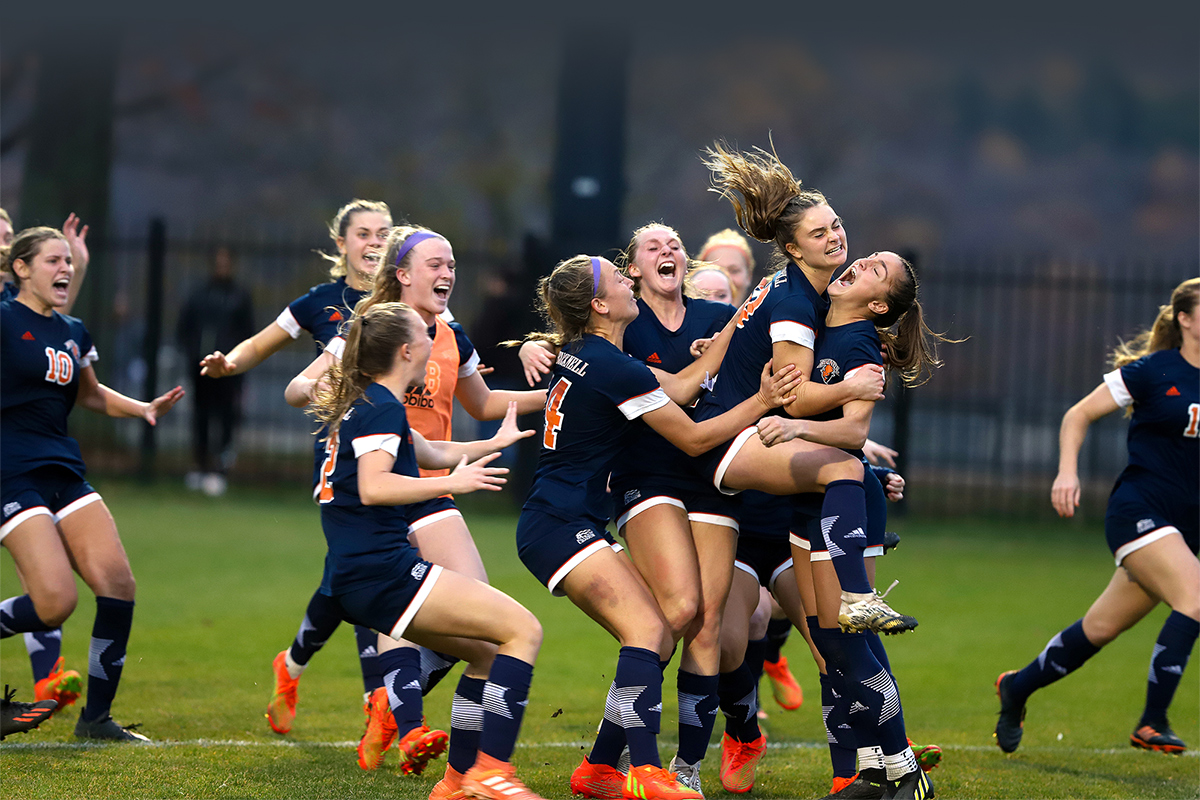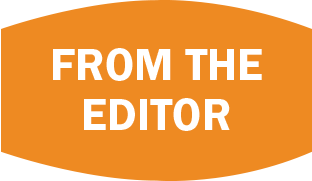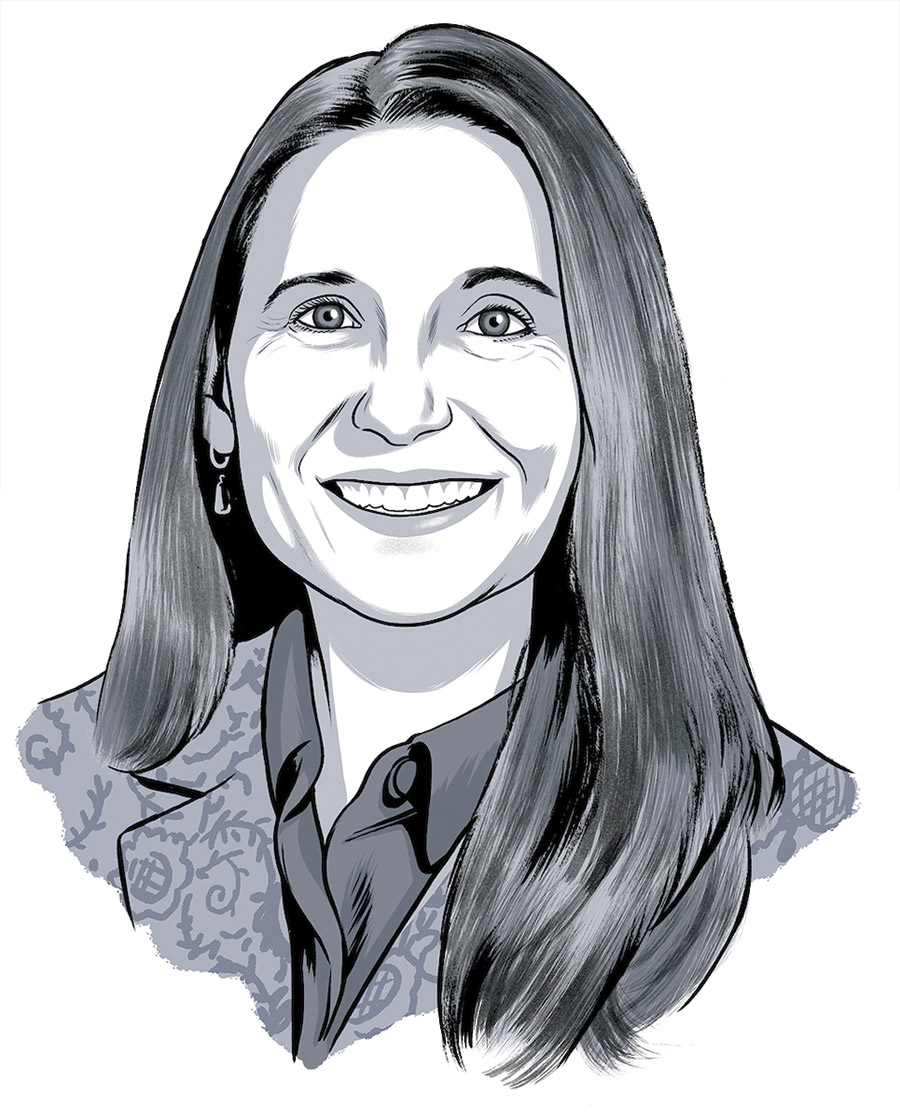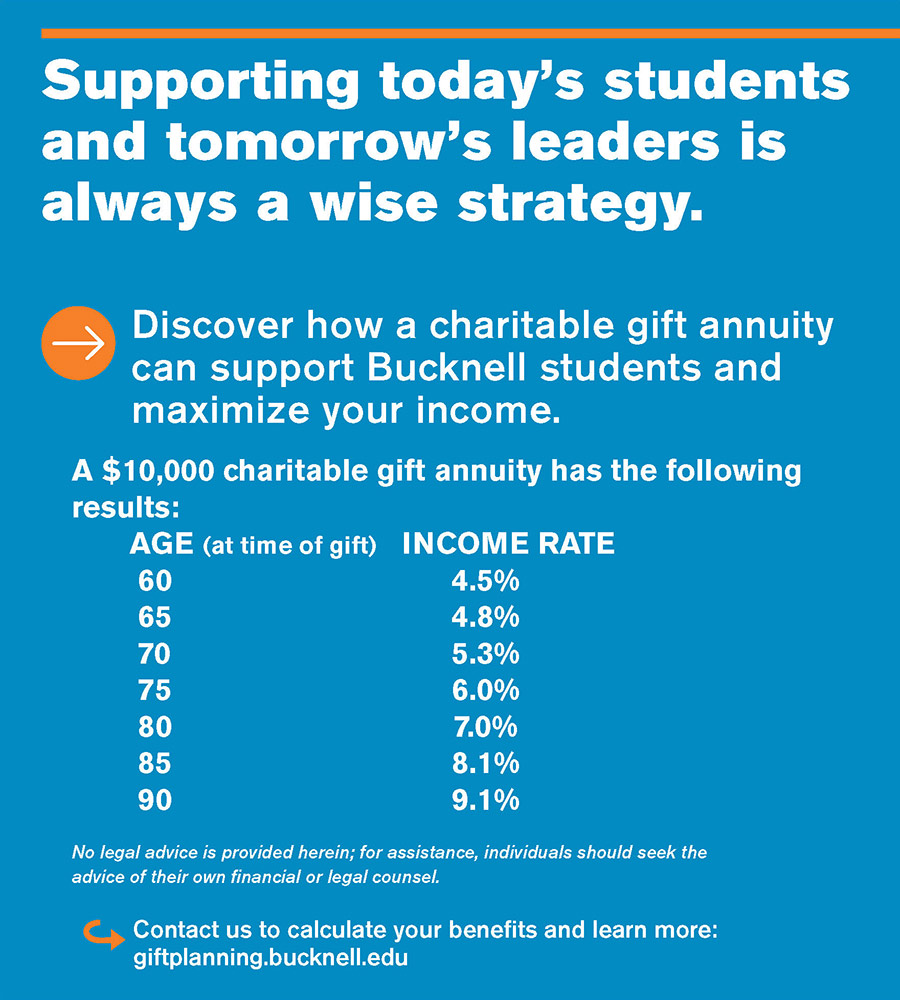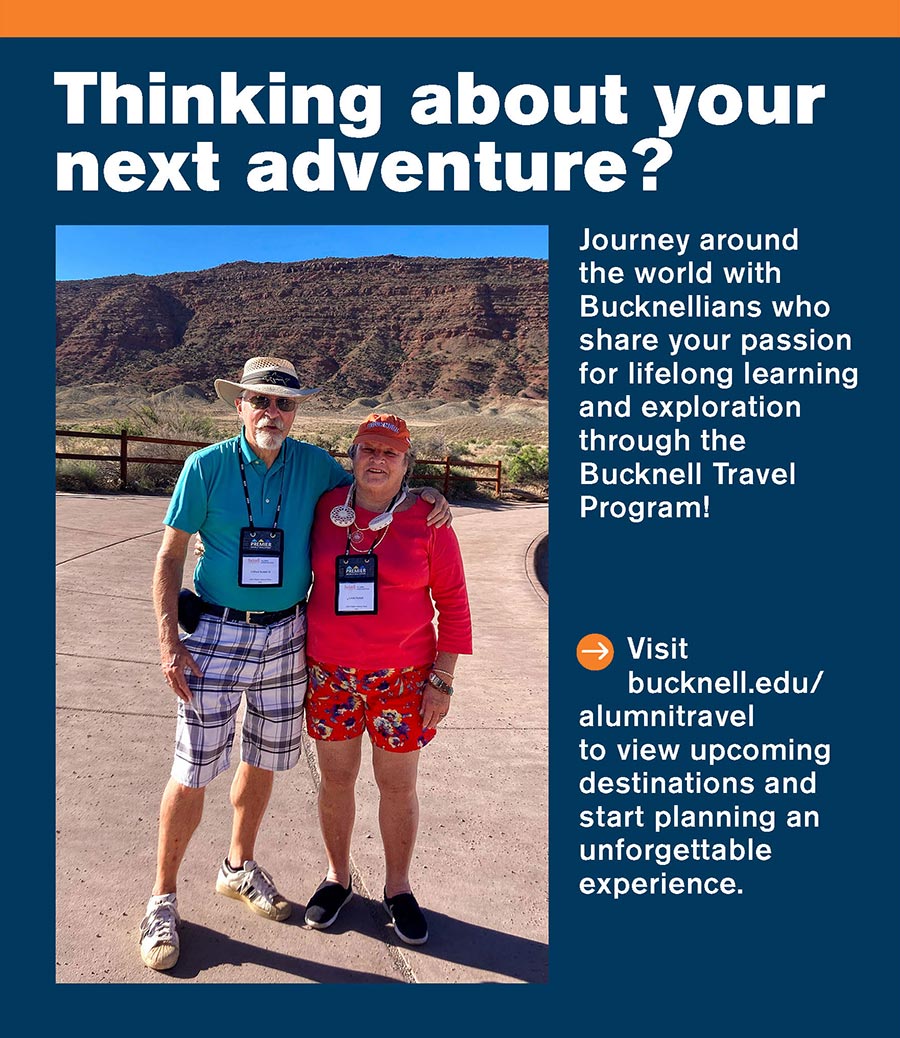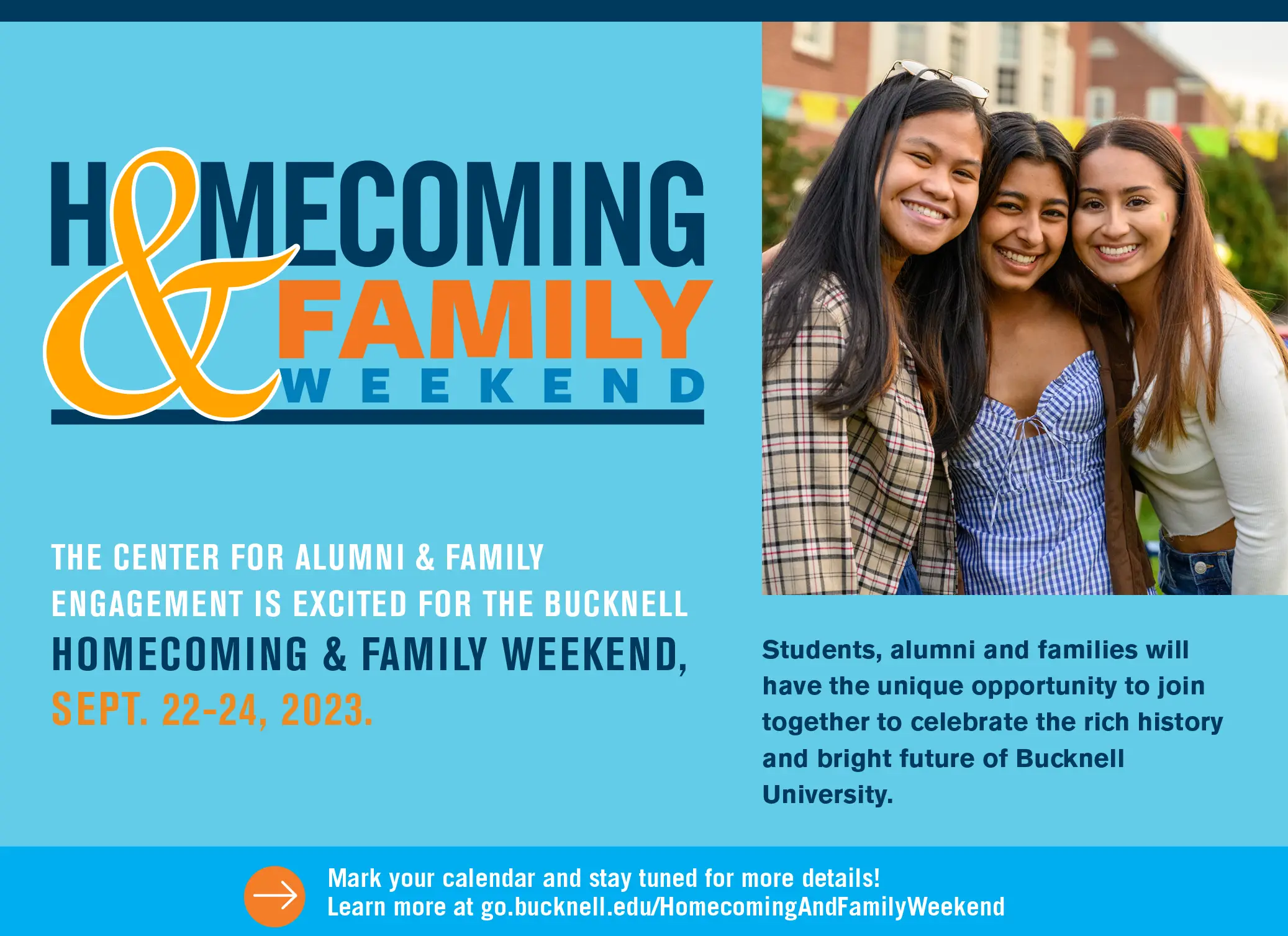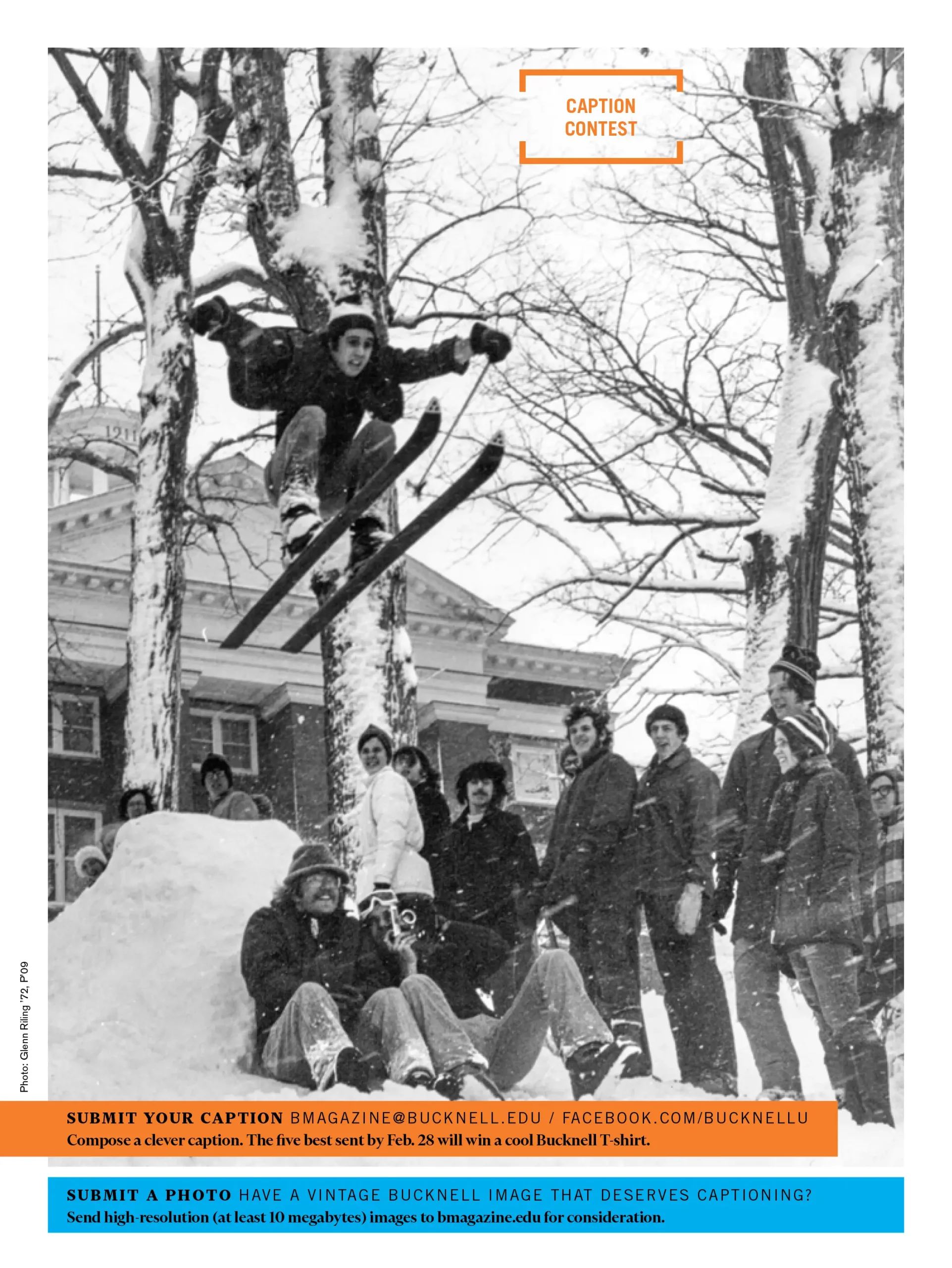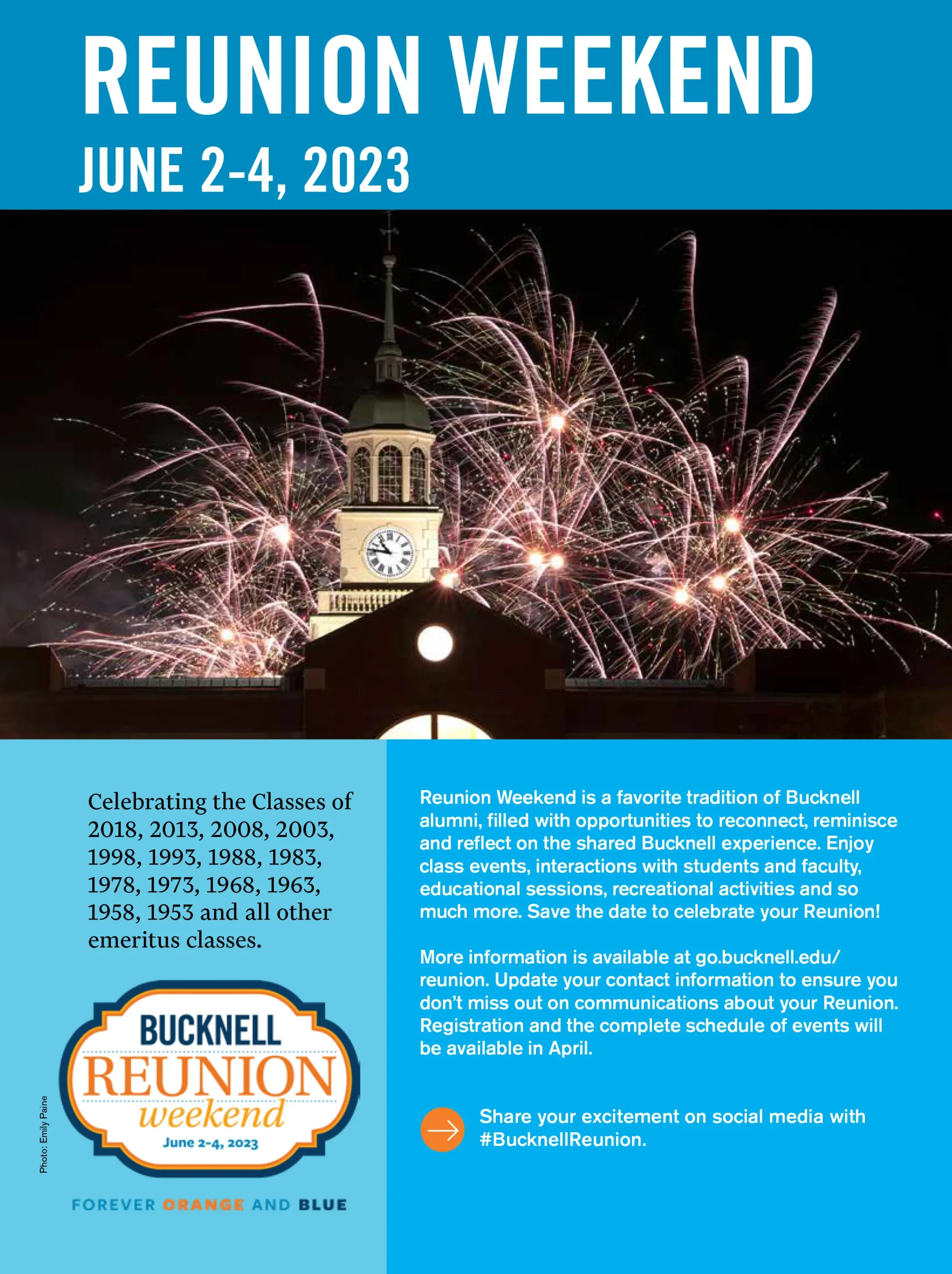BY WAY OF BUCKNELL
PRETTY PEACEFUL
A fresh coat of snow adds beauty and tranquility to campus.
If you would like a reprint of this photo, please fill out the form at go.bucknell.edu/PhotoOffer. We will send you a complimentary 8 x 10 print.
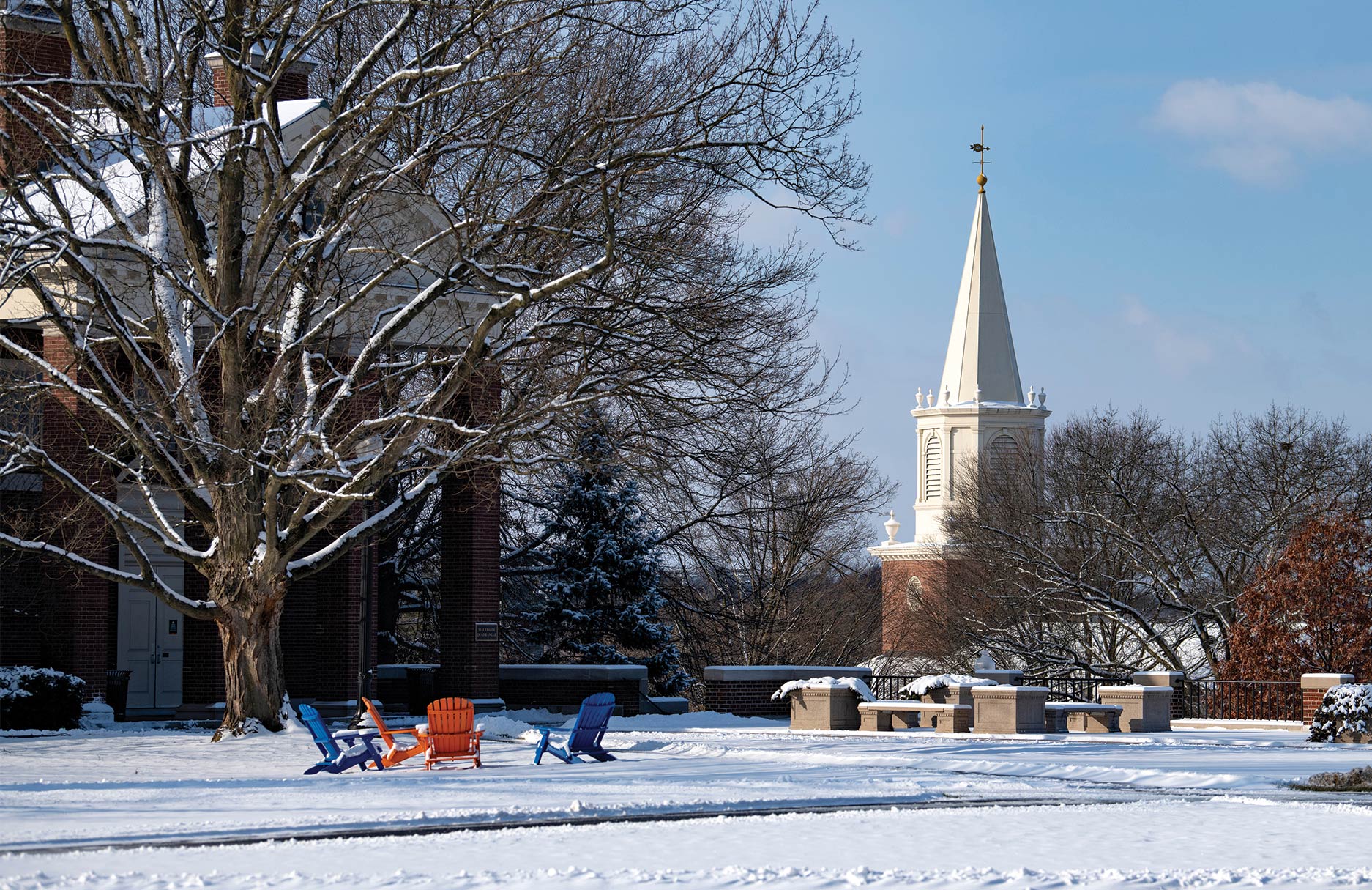
BY WAY OF BUCKNELL
A fresh coat of snow adds beauty and tranquility to campus.
If you would like a reprint of this photo, please fill out the form at go,bucknell.edu/PhotoOffer. We will send you a complimentary 8 x 10 print.
Pathways
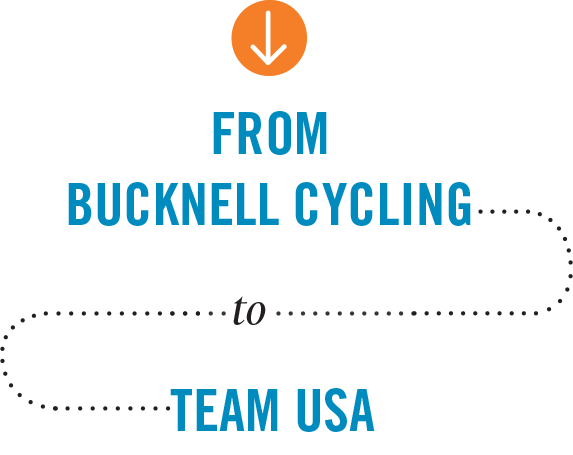
by BROOKE THAMES
Kelly Desharnais Catale ’12 came to Bucknell a track and field athlete but left a very different kind of racer.
After a broken femur forced her to hang up her spikes, Catale went looking for a new sport to satisfy her inner competitor.
“One of my friends kept telling me that I’d make a great cyclist, so I bought a bike and decided to join the Bucknell cycling club,” says Catale, who majored in biomedical engineering. “I fell in love with being out on the roads, riding through the countryside.”
Pathways


Kelly Desharnais Catale ’12 came to Bucknell a track and field athlete but left a very different kind of racer.
After a broken femur forced her to hang up her spikes, Catale went looking for a new sport to satisfy her inner competitor.
“One of my friends kept telling me that I’d make a great cyclist, so I bought a bike and decided to join the Bucknell cycling club,” says Catale, who majored in biomedical engineering. “I fell in love with being out on the roads, riding through the countryside.”
EARLY INNOVATOR
Midlothian, Va.
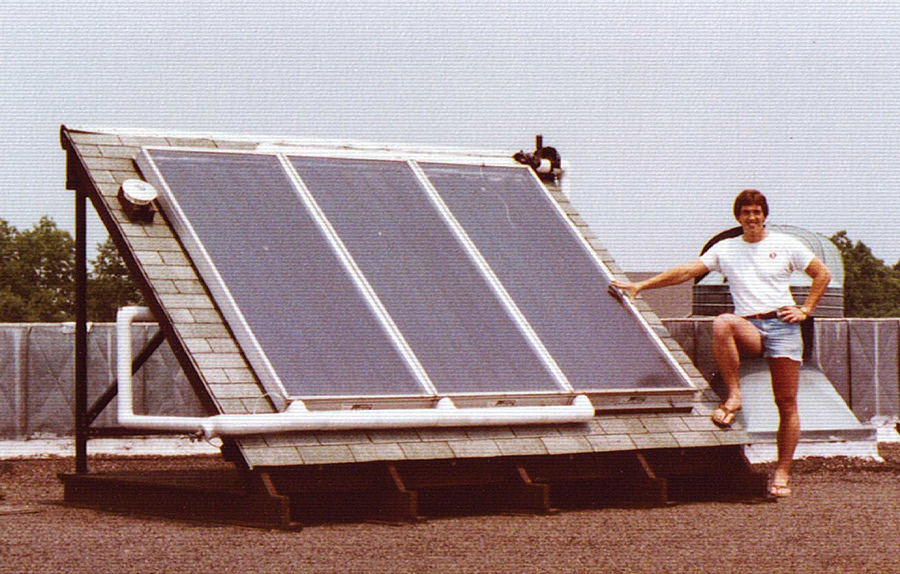


LETTERS TO THE EDITOR POLICY
The editors reserve the final decision to publish any letter — there is no guarantee that all letters received will be published.
All letters must be signed. The maximum length is 300 words. The editors reserve the right to edit letters for clarity and space. Writers may be asked to submit revised versions of letters or to approve editorial changes made by the Bucknell Magazine editor. After two issues, the debate on any topic will conclude. Some letters may be disseminated only online. Views expressed in this magazine do not necessarily reflect the opinions of the editors or the official views or policies of the University.
‘New Year, New You!’
Indeed, the transition from one year to the next inspires many people to reflect on the past and set intentions for the future. For the readers I once served, those intentions often materialized as lifestyle goals — from the modest (like consuming more plant-based protein) to the momentous (qualifying for the Boston Marathon).
Big or small, each goal held the promise of a better future. Helping people live fuller lives was the mission of Rodale, the publishing company that was my professional home for 18 years, and I embraced it wholeheartedly. I spent most of my career at Runner’s World magazine sharing readers’ stories. My favorite features had a common thread: A simple act — putting one foot in front of the other — had a profound impact, enabling people to overcome challenges, unlock opportunities, and find inspiration, purpose and community.
After making a career transition into higher-ed communications five years ago, I realized my work, at its core, remains the same. I share stories that help people overcome challenges, unlock opportunities, and find inspiration, purpose and community — only now the common thread is the profound, life-shaping power of education. Attending college is one of the most significant, consequential decisions a person ever makes. Education’s tremendous lifelong impact is a compelling story that’s rewarding to share.
As I write this note, 2022 is drawing to a close, and I’m reflecting on the idea of “new year, new me.” 2023 holds excitement and promise as I settle into my role with the talented Bucknell Communications team as the new caretaker of Bucknell Magazine. I have tremendous respect for its most recent editor, Sherri Kimmel. Her commitment to editorial excellence and passion for thoughtful storytelling is apparent in each issue she produced.
Storytelling has the power to stimulate us intellectually and emotionally. It informs and educates while also deepening our connections with each other. I recognize that Bucknell is more than just an institution of excellence; it’s a forever home to a passionate community of people who have a special bond because of their shared experiences here.
I am grateful for the opportunity to help strengthen those connections through the pages of this magazine. I look forward to sharing your wisdom, your accomplishments, your memories — in other words, your stories.
WHERE’S MY MAG?
Here is the new schedule:
SPRING ’23: April
SUMMER ’23: August
FALL ’23: November
WINTER ’24: February
Table of Contents

Volume 16, Issue 1
Heather Johns P’27
EDITOR
Katie Neitz
CREATIVE DIRECTOR
Barbara Wise
DESIGNERS
Amy Wells
Barbara Wise
PHOTOGRAPHY EDITOR
Emily Paine
DIGITAL EDITOR
Brooke Thames
ASSISTANT EDITOR
Katie Williard
CLASS NOTES EDITOR
Heidi Hormel
EDITORIAL ASSISTANT
Kim Faulk
Contributors
Dave Block
Shana Ebright
Mike Ferlazzo
Matt Hughes
Brad Tufts
Christina Masciere Wallace P’22
Website
bucknell.edu/bmagazine
Contact
Email: bmagazine@bucknell.edu
Class Notes:
classnotes@bucknell.edu
Telephone: 570-577-3611
Bucknell Magazine
(ISSN 1044-7563), of which this is volume 16, number 1, is published in winter, spring, summer and fall by Bucknell University, One Dent Drive, Lewisburg, PA 17837. Periodicals Postage paid at Lewisburg, PA and additional mailing offices.
Permit No. 068-880.
Circulation
49,000
Postmaster
Send all address changes to:
Office of Records,
301 Market St., Suite 2
Bucknell University, Lewisburg, PA 17837
© 2023 Bucknell University
Please recycle after use.
INFLUENTIAL GIFT
A New Gateway to Bucknell
Bucknell has long been committed to helping students overcome financial hurdles in their pursuit of higher education. And now, thanks to the generosity of Bob ’84, P’16 and Sue DeMent Gamgort ’84, P’16, Bucknell’s incoming Class of 2027 will have additional support via the Bucknell Gateway Scholars Program.
This new initiative will meet the full demonstrated need of 20 first-generation students each year, eliminating federal loans from their financial aid packages. The program provides more than just financial aid. Each scholarship recipient will benefit from ongoing outreach, mentorship and guidance that will support their success.
News Ticker
LASER FOCUS
In 2023, Bucknell will be home to a state-of-the-art instrument that will enrich students’ ability to study atomic and molecular physics. A $349,909 National Science Foundation award will fund a frequency-quadrupled titanium sapphire laser, which will enable both Bucknell and Susquehanna University students to study nuclear structures and investigate molecular collisions.
CULTIVATING CURIOSITY
Professor Donna Ebenstein, biomedical engineering, has been named an Engineering Unleashed Fellow, a designation that recognizes leadership in undergraduate engineering education. The Engineering Unleashed program helps engineering faculty across the country work to integrate an entrepreneurial mindset into their practices, their institutions and society at large.
VALUING OUR PEOPLE
Bucknell continues to distinguish itself as a premier employer. In 2022, the University committed to a two-week December-January break and piloted a week-long Thanksgiving break for employees. Tuition benefits and wellness programs are also part of Bucknell’s robust benefits package.
AROUND TOWN AND AROUND THE GLOBE
’burg and Beyond
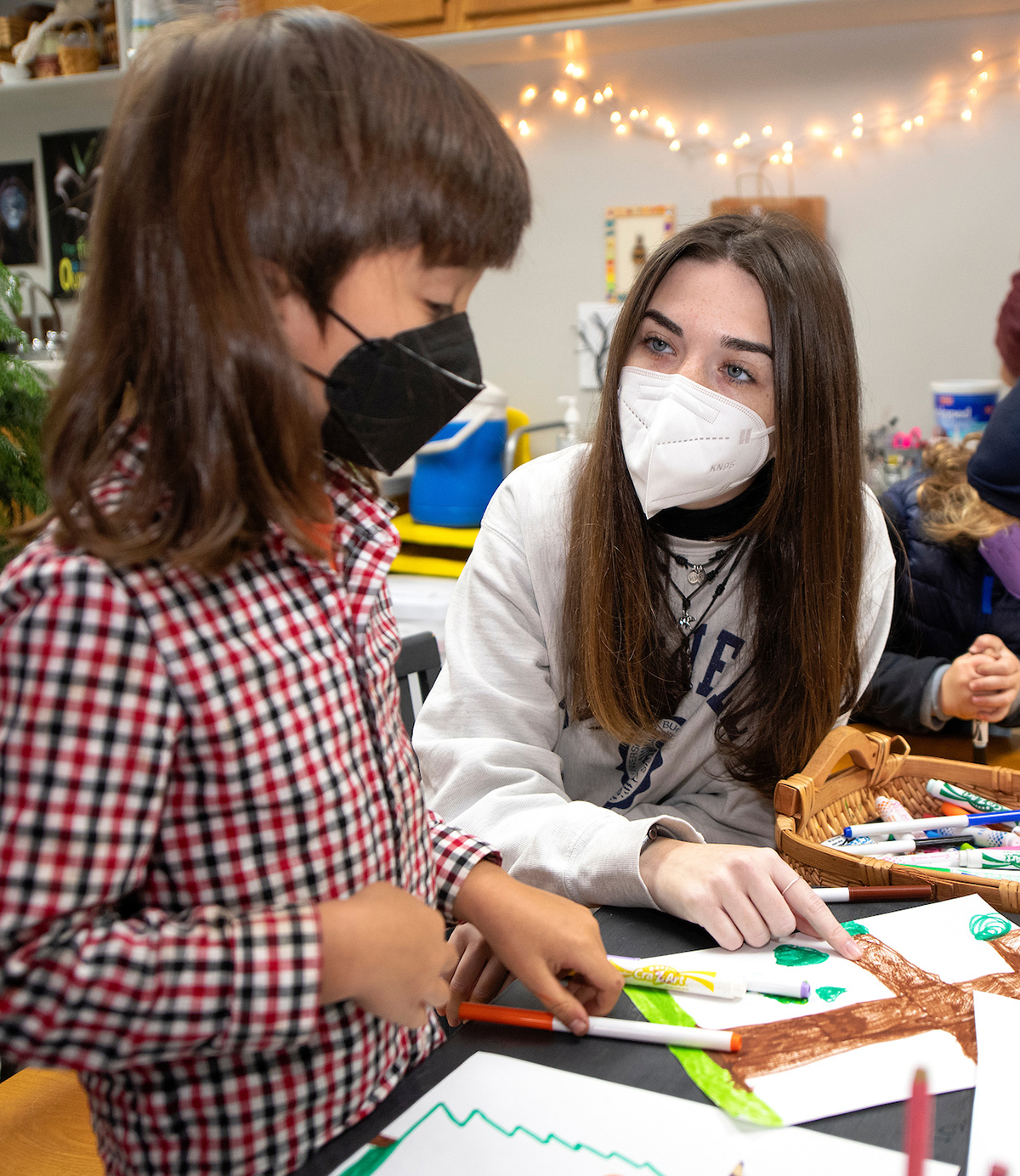

 Lewisburg, Pa.
Lewisburg, Pa.You might not expect a college student’s favorite people to be less than half her age. But as the eldest of six siblings, Elle Chrampanis ’24 is fascinated by the wide-eyed wonder of children — and invested in nurturing their growth.
It’s a passion that informs her studies at Bucknell, where she’s examining child development through local student-teaching opportunities.
What She’s Investigating
A psychology and music double-major from Little Silver, N.J., Chrampanis is crafting an honors thesis on the impact of music education on children’s mental and emotional well-being.
AROUND TOWN AND AROUND THE GLOBE
’burg and Beyond
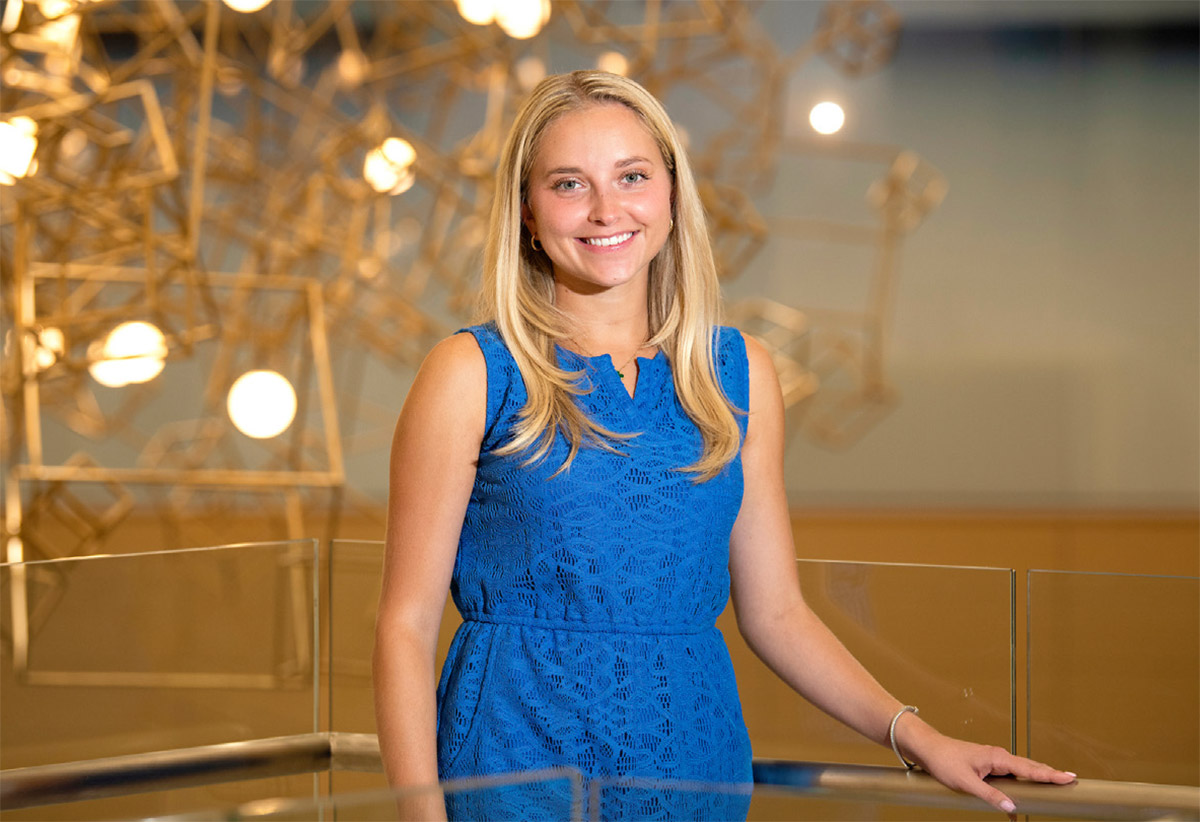

 London
LondonWalking past school groups and tourists, Hollie Walters ’24 flashed her pass and waltzed into the Houses of Parliament.
“It’s very grand to go into the House of Commons and watch debates and be behind the scenes of government processes,” she says. “It was surreal at times, and the best experience.”
A global management and political science double-major from Gibsonia, Pa., Walters spent her summer interning for Member of Parliament Tulip Siddiq of the Hampstead and Kilburn constituency in North London. Through Bucknell’s Office of Global & Off-campus Education, she identified a partner program through Arcadia University that allowed her to both participate in the internship and take a contemporary British politics class during her experience abroad.
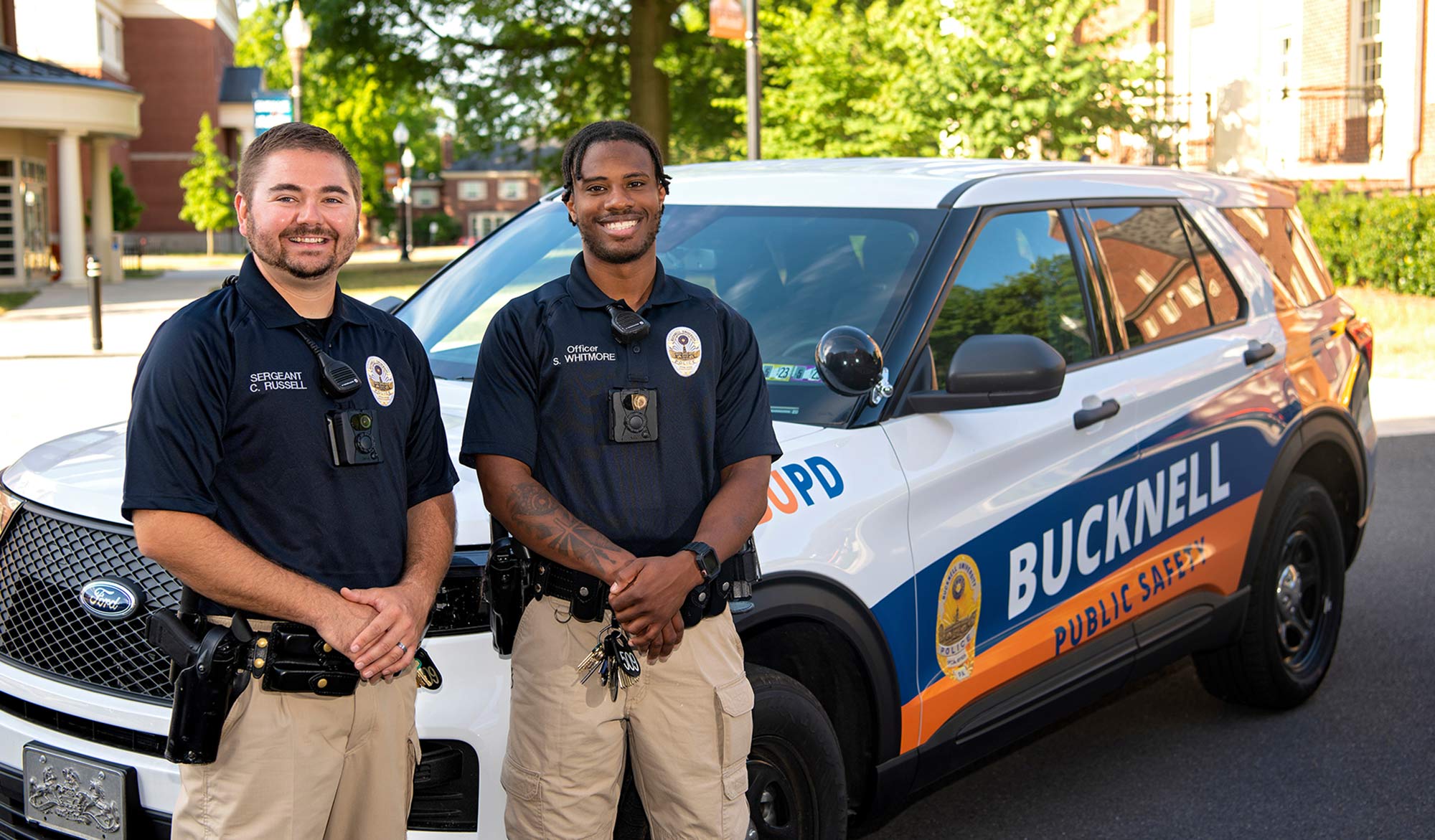

Under Morgan’s leadership, Bucknell became one of the first two universities in the nation to implement the Guardian Score law enforcement assessment tool, which was featured in a Washington Post story. Public Safety officers now hand out business cards with a QR code following all interactions with members of the community. The QR code leads to a Guardian Score survey that collects feedback on the experience.
“The more data we get, the better our response to concerns,” Morgan says. “We want to make sure we’re treating people with equity. This helps to validate our program and highlight areas that we can improve upon.”
President Bravman’s Leadership Continues
THE BUCKNELL UNIVERSITY Board of Trustees unanimously voted in October to extend President John Bravman’s contract through at least 2028. This is Bravman’s second extension; in April 2018, the board unanimously voted to extend his contract through June 2025.
Bravman became the University’s 17th president on July 1, 2010, after a long career at Stanford University, and by the end of his current contract will have the third-longest tenure among Bucknell presidents.
“The length of John’s tenure reflects the confidence and trust the Board of Trustees has in him to continue his exceptional leadership of the University,” says Board Chair Chris O’Brien ’80, P’18, P’20.
“It is truly an honor and privilege to continue serving Bucknell as its president, and I am thankful for both the board’s continued confidence in me and the extraordinarily talented students, faculty and staff who make this such a special place,” Bravman says.
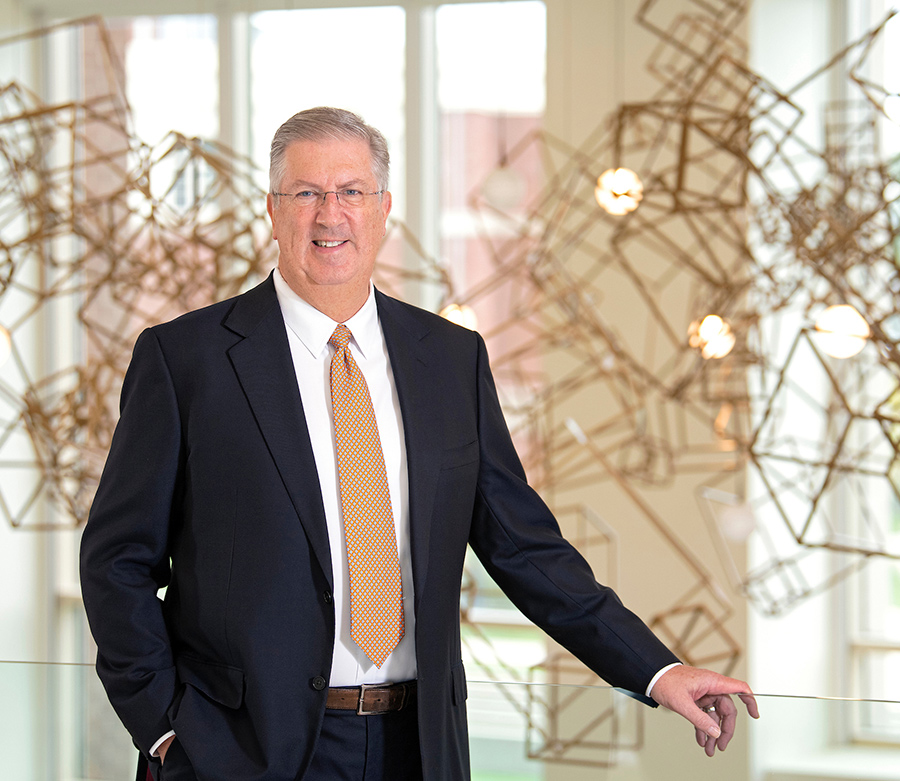



not just speed.
Finding Her Rhythm
Among competitive swimmers, the breaststroke is considered the toughest stroke. Arms, legs and head must pull, kick and bob in hyperkinetic sync. It’s no easy feat.
You wouldn’t know that watching Catherine Craig ’23. Craig is a breaststroke master who chews up the competition with her strong forward propulsion and smooth, streamlined glide. It’s why she was recruited to swim at Bucknell.
Explaining her success, Craig is every bit the technician. “The breaststroke is a major rhythm stroke — it takes power with timing and technique to go fast,” says the economics and psychology double-major from Mansfield, Pa. “I’ve focused a lot on counting my strokes and making sure that I time my walls so that I’m not too far away or cutting off a stroke. But I don’t always count during races because sometimes I just want to be present in the pool and go for it.”
Created in partnership with the RW Jones Agency, a national firm focused on media relations in higher education, The Presidents Dinner has raised Bucknell’s profile and enhanced Bravman’s reputation as a thought leader, resulting in interviews with The Wall Street Journal, USA Today, The Washington Post, The Philadelphia Inquirer, The Chronicle of Higher Education and Inside Higher Ed.
Following two years of virtual gathering, Bravman returned to the famed National Press Club in Washington, D.C., to lead the discussion among 10 presidents and more than 20 national media members.
While Bravman reflected on how Zoom helped preserve the event, he shared enthusiasm about meeting in person again. “I think I speak for us all when I say it’s great to not be staring at a screen, and to share in a delicious meal together once again,” he said.
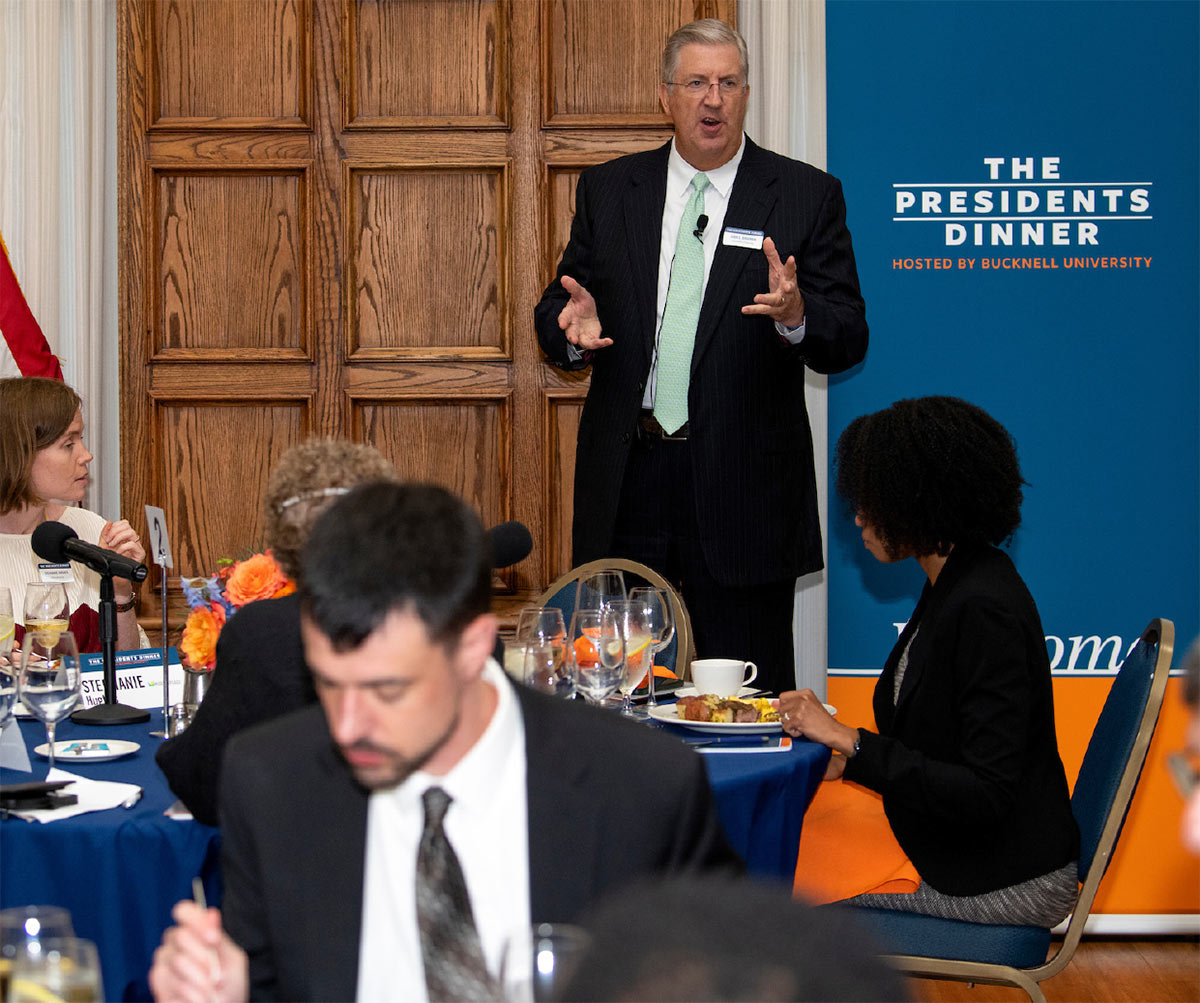
Photo: Emily Paine

end of an era
Home Sweet Home
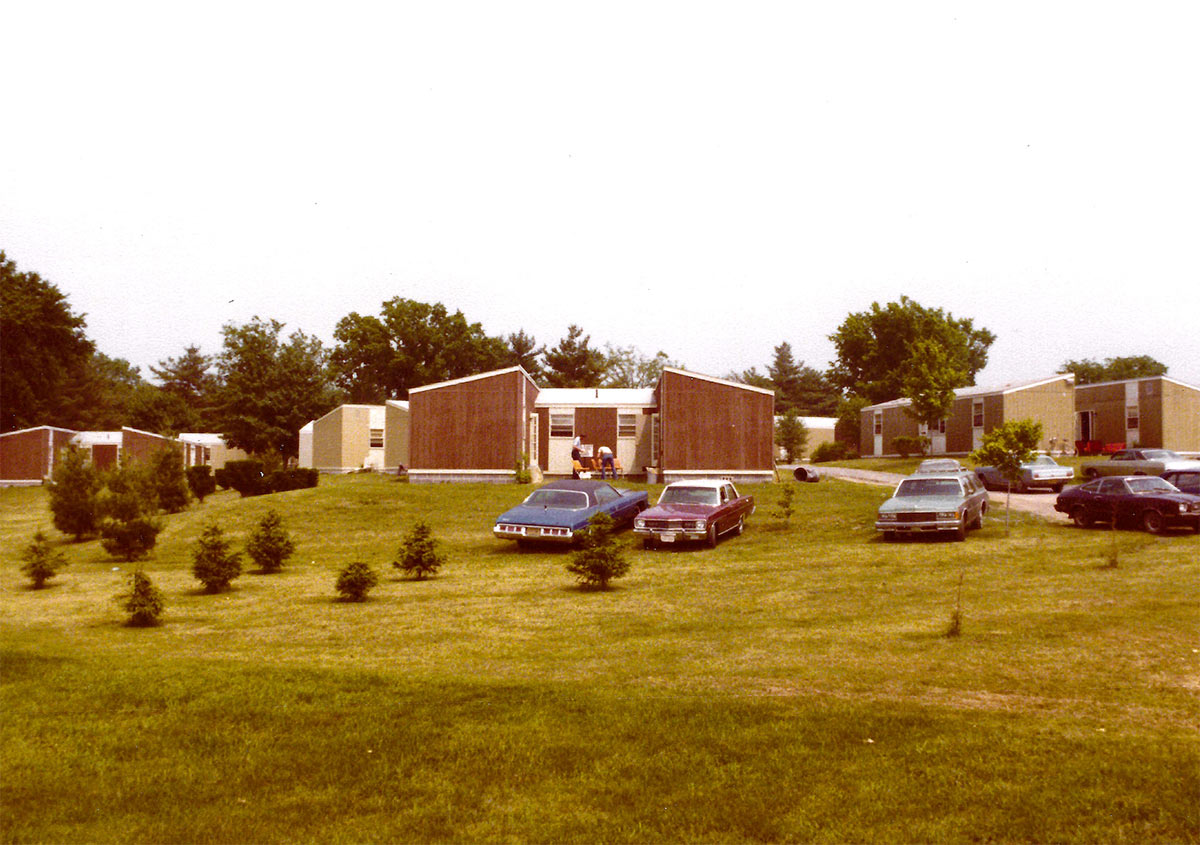

hat makes a house a home? Many say it’s the people who reside within it.
That’s certainly the case for the Bucknellians who called the Bucknell West complex — aka the Mods — home. For 50 years, the distinctive H-shaped housing units accommodated 272 sophomores, juniors and seniors who developed their own homegrown microcosm of the Bucknell community on the west side of campus.
When the units were built in 1972, they were intended as temporary housing to accommodate the influx of the boomer generation students enrolling in Bucknell. It’s unlikely administrators of that era would have expected the structures to endure for five decades.
While the Mods were maintained with care over the years, there was recognition that fresh paint and regular repairs can only take a building so far. To fulfill its goal of providing students with a superior learning and living environment, Bucknell is in the process of replacing the Mods with a modernized residential complex.
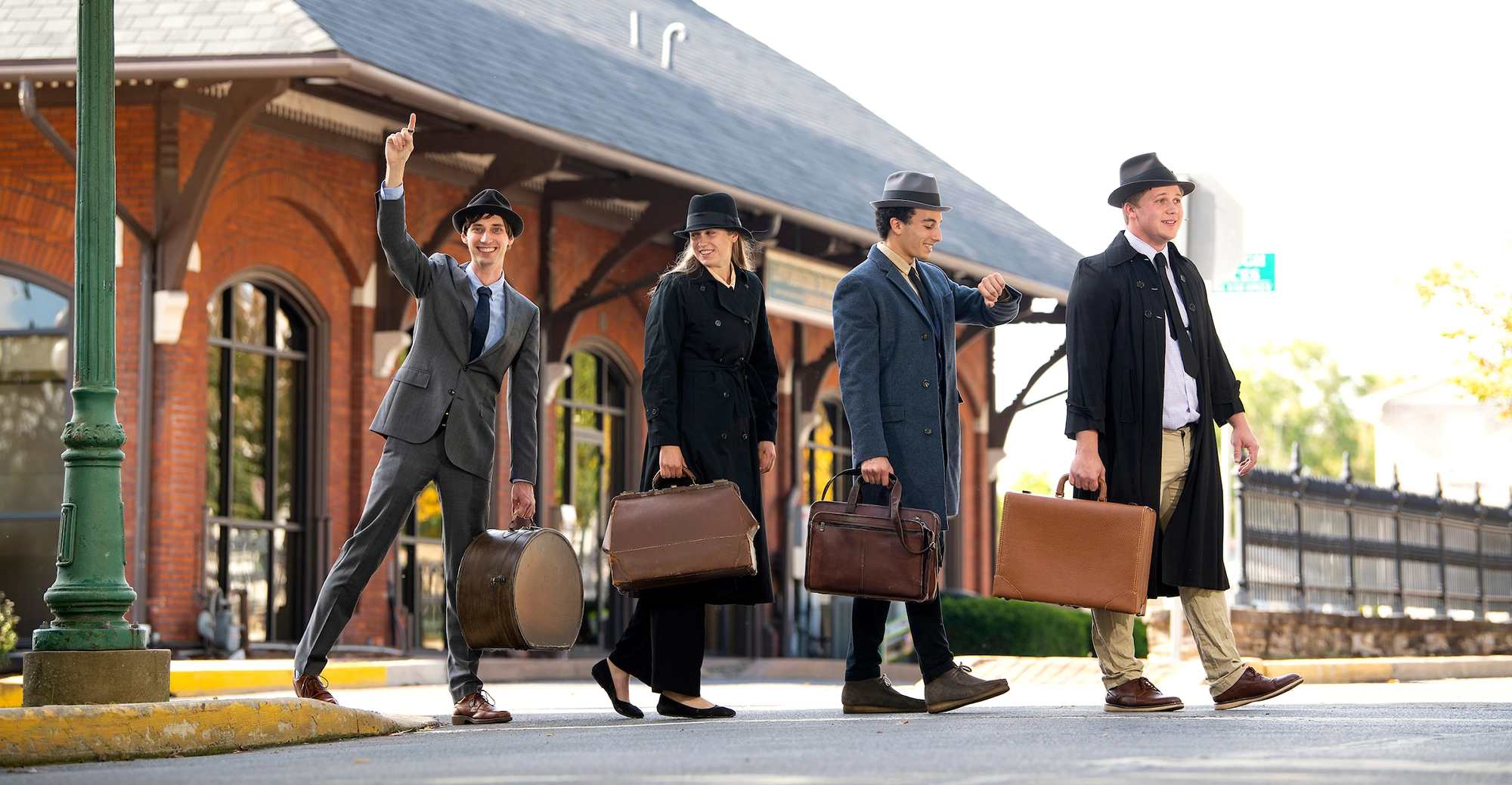
The Problem with Salesmen
A TRAVELING SALESMAN stands at a train station in St. Louis, carefully considering his path. He must make stops in Chicago, New Orleans and Mason City, Iowa, among others, before returning home. And he wants to be efficient about it. So how can he plan the best route, visiting each stop only once and traveling the shortest distance?
It’s a question that has existed for centuries — with applications ranging from route planning to DNA sequencing — and each new discovery only provides more possibilities to explore. That’s what makes it so intriguing to Professor Sam Gutekunst, the John D. & Catherine T. MacArthur Assistant Professor of Data Science, and his student researchers.
Supported by a National Science Foundation grant, Gutekunst is exploring the famous Traveling Salesman Problem (TSP) with help from Asta Rustad ’23, Yacine Bouabida ’24 and Austin Beal ’24.
BUCKNELL’S
BRIGHT FUTURE
Bucknell took a step closer to achieving its goal of reaching carbon neutrality by 2030 with the installation of a new 1.76-peak megawatt solar array. The installation, which sits between the Bucknell Golf Club and the Art Barn complex, was built in partnership with Encore Renewable Energy of Burlington, Vt., under the direction of Chad Farrell ’92, Encore’s founder and CEO. In addition to supplying the equivalent of approximately 7% of campus electrical usage and providing Bucknell with price certainty on energy rates for the next several decades, the array also will serve as a living lab for students. The project demonstrates Bucknell’s commitment to reducing emissions and supporting renewable energy.
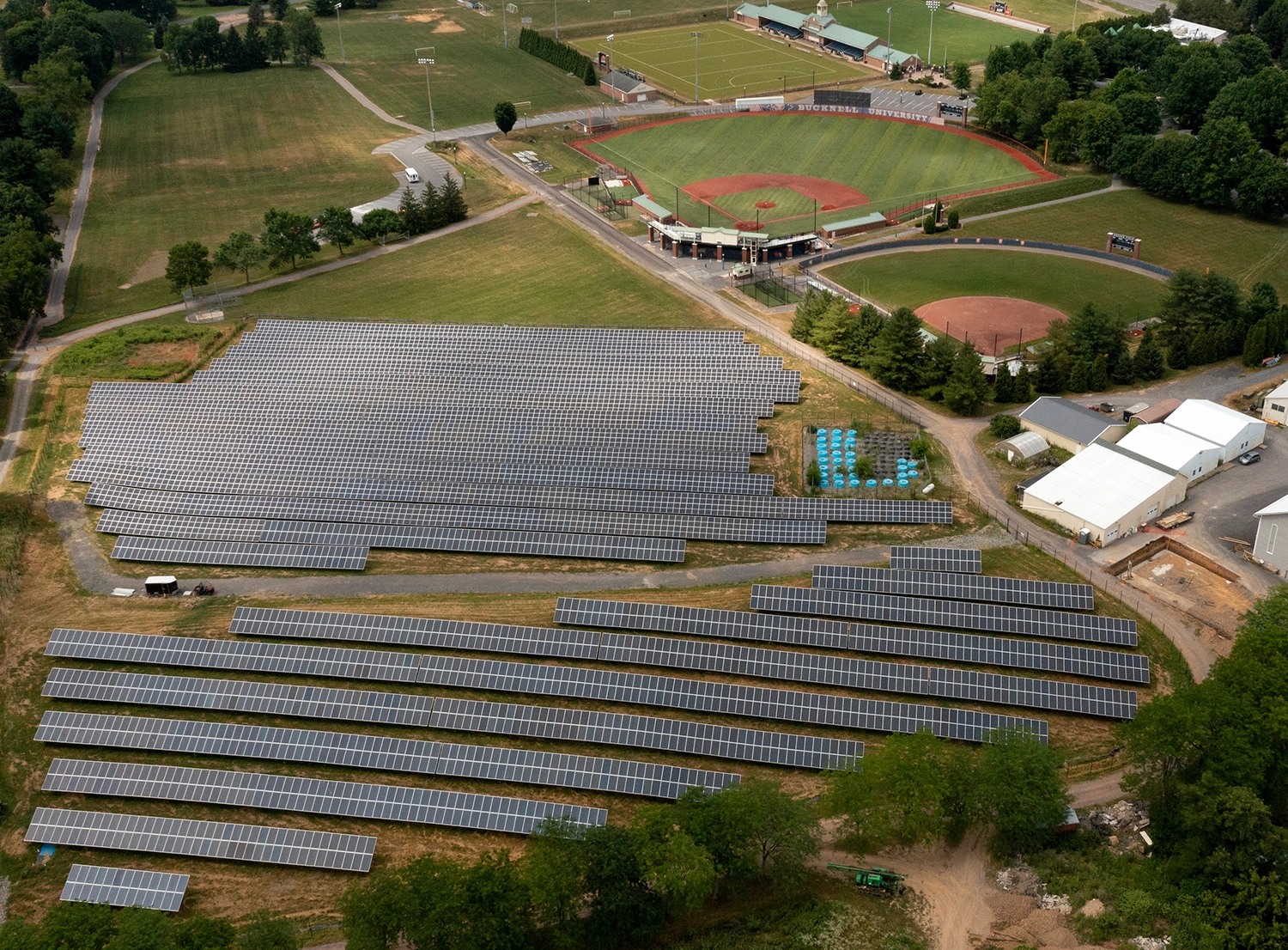
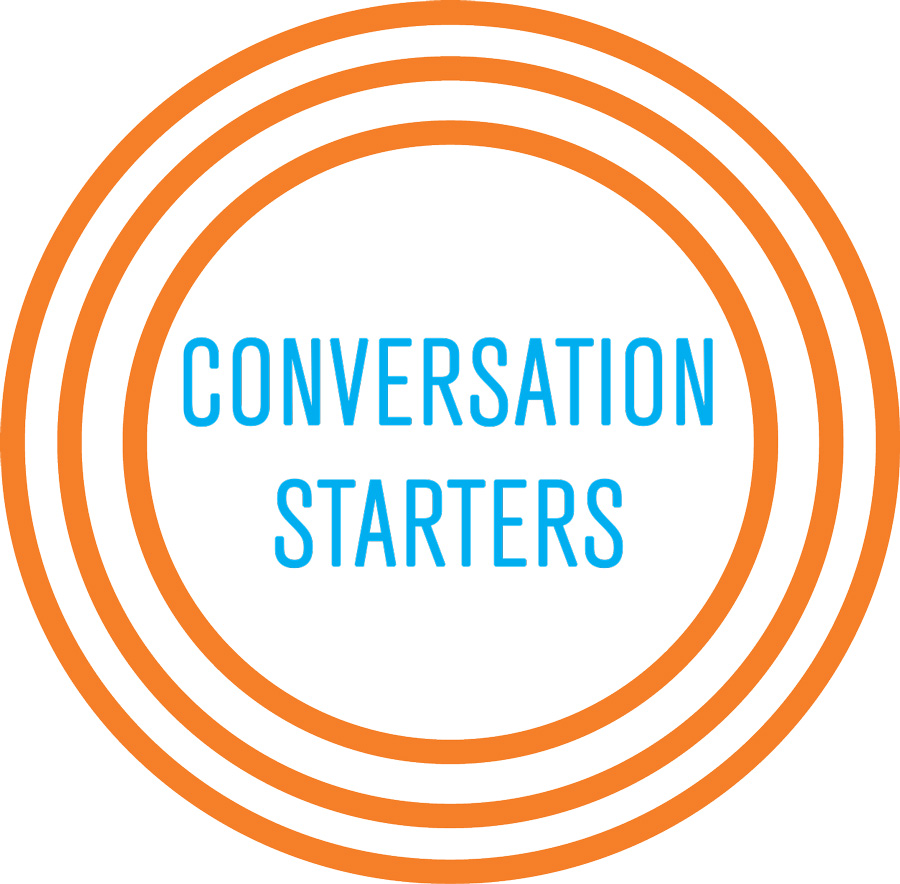
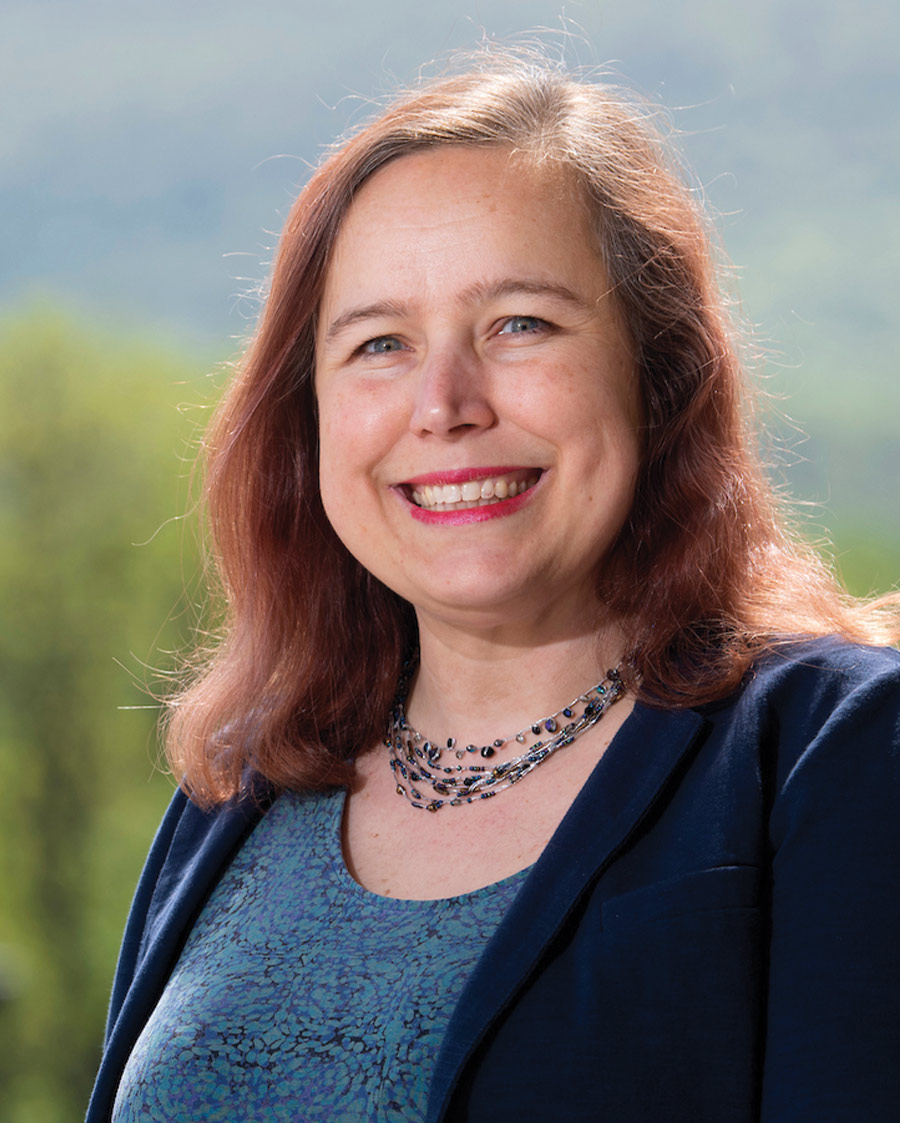
Photo: Emily Paine
chemical engineering
WHY DO WE FROST CAKE?
Historically, sugar was an expensive commodity, so using it not only as a basic ingredient but as added flair on the outside of the cake enabled the affluent to tout their wealth.
Aesthetics come into play with decoration. There’s a fair argument to be made for sugar being easier to manipulate than cake itself. It’s much harder to carve cute, colorful roses out of cake than to sculpt them with frosting. It provides the opportunity for refinement and detail that molds and carving can’t reach alone.
Finally, and most interestingly for me, icing’s high sugar content makes it preservative in nature, so mold and bacteria cannot grow on it. And that’s because of a thermodynamic concept called water activity. This refers to the amount of free water available to participate in chemical or biological purposes, and it impacts the shelf life of foods. A food like cake will keep longer and resist spoilage if it’s covered in sugar-laden frosting because the frosting has a low level of water activity.
And so, frosting allows us to wrap our cakes beautifully for safekeeping. What could be sweeter?
artistic fusion
Making Music Together
shi Day ’04 sees a not-so-golden thread woven through human history: witch hunts, in which persecutors exert accusations of wrongdoing against powerless victims. “This is a thing that societies keep doing over and over again, and we are failing to learn from it,” she says.
Day tackles this abuse of power through a one-act opera she composed, Waking the Witch. She workshopped the opera in December in Washington, D.C., with director Lee Cromwell ’05 in preparation for an eventual premiere performance. The duo forged both their friendship and creative partnership while studying together at Bucknell.
Waking the Witch received funding last year from OPERA America’s Opera Grants for Women Composers: Discovery Grants program, supported by the Virginia B. Toulmin Foundation. “It gives you some funds to pay musicians, rent space, pay for music copying or whatever it is that you need in order to transform the piece from an idea in your head into something you could bring to opera or theatre companies looking to produce new works,” Day says.

Jill Britton ’19
Jill Britton ’19
At NPR, Jill Britton ’19 helps produce concerts for a delightfully creative corner of the internet — the Tiny Desk Concert Series. The unplugged, intimate performances are recorded live behind the working desk of series creator Bob Boilen at the NPR headquarters in Washington, D.C. Behind the cameras sit the desks of other NPR music staff — including Britton. Her work delivers music to the ears of over 7 million subscribers.
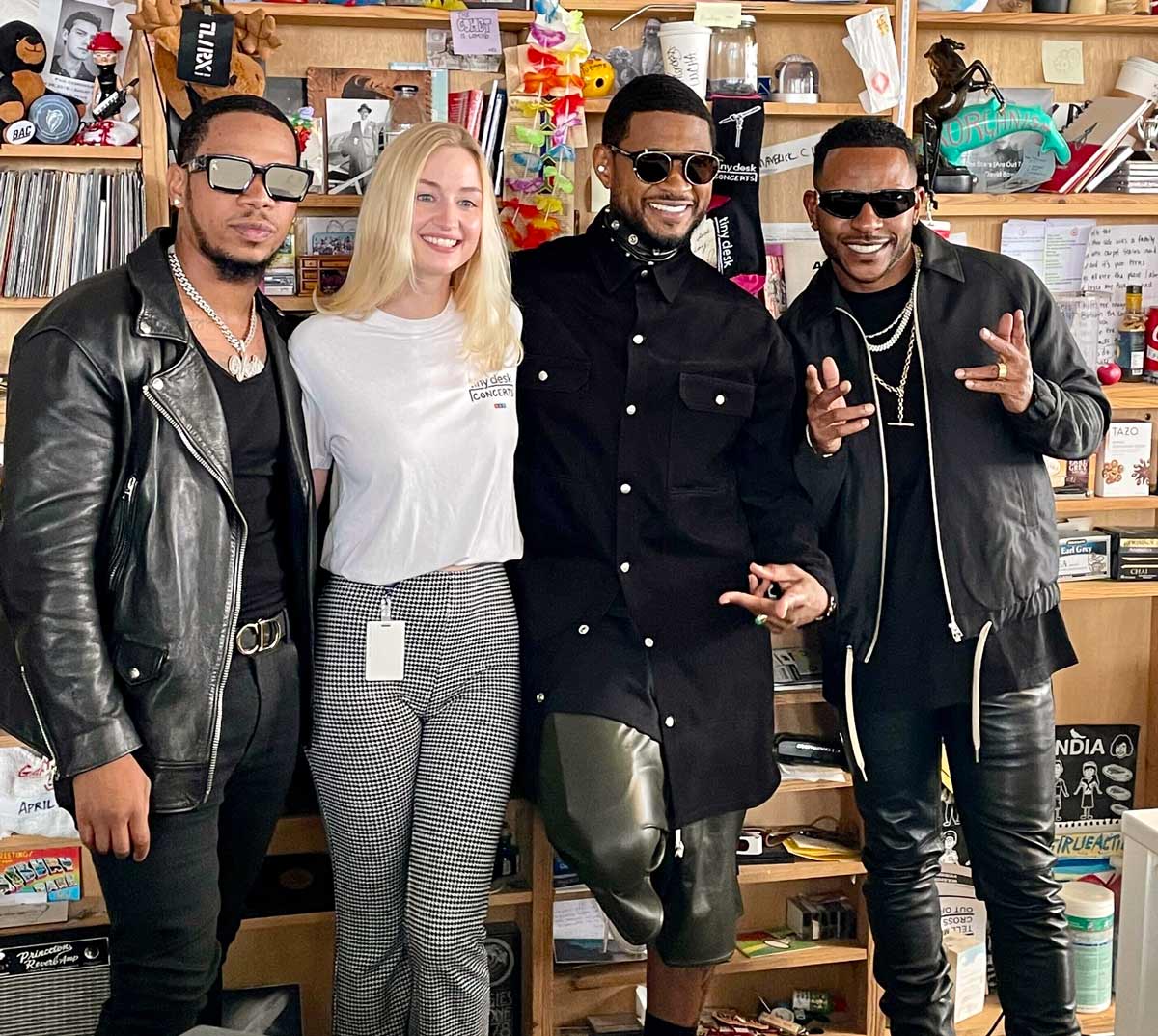

Photo: Courtesy of Jill Britton ’19
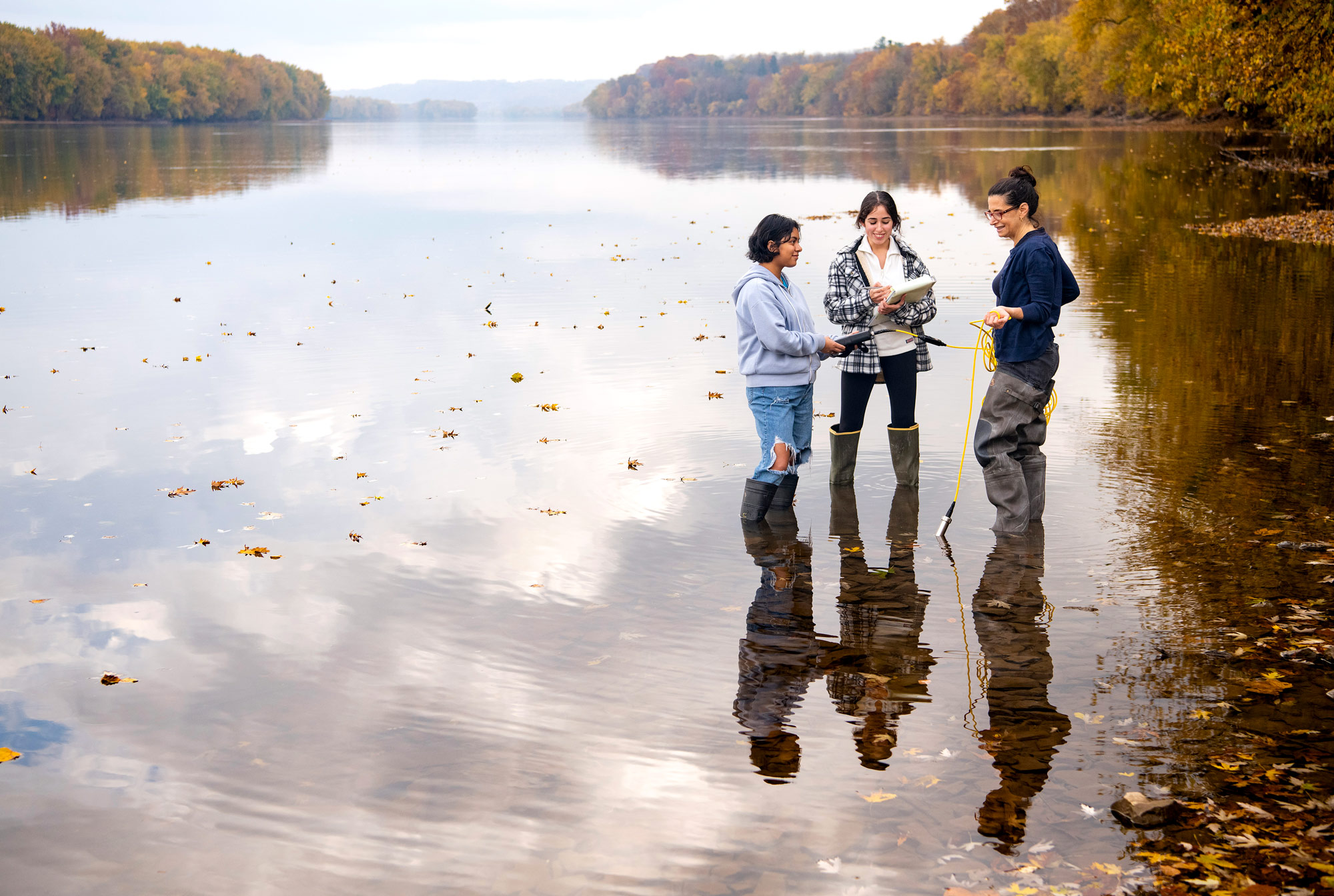
From left: Demi Gonzalez ’26, Melanie Gamboa ’24 and Professor Deborah Sills, civil & environmental engineering, test water in the Susquehanna River.
Engineering the Future — for Good

photos by emily paine
From left: Demi Gonzalez ’26, Melanie Gamboa ’24 and Professor Deborah Sills, civil & environmental engineering, test water in the Susquehanna River.

Katherine Owens Hayden P’48 was one of the trailblazers of this era. In 1923, she became the first woman to earn an engineering degree from Bucknell University. Though Bucknell had been co-educational since 1852 — notably just six years after its chartering — engineering was the last domain on campus for women to access.
“The 100th anniversary of Hayden’s graduation is significant,” says Erin Jablonski, associate dean of engineering. “Other schools have recently celebrated 50 years of women in engineering, which coincides with Title IX. That means they had to accept women. Bucknell was progressive, and we should celebrate and be proud of that.”
Hayden may have been a new student, but she wasn’t new to campus or a stranger to faculty. Her father, William Owens, Class of 1880, H’35, headed the chemistry department and helped create the chemical engineering program in which his daughter enrolled. But his connections didn’t earn her any favor. “I was the first gal in the course, and the boys all liked to play tricks on me. Even the professors liked to give me things that didn’t work,” she told Bucknell World in 1993. In fact, mechanical engineering professor Frank Burpee P’31, P’35 even refused to let Hayden into his mechanical drawing class.
Claiming Their Place in Engineering

by EVELINE CHAO
illustrations by BARBARA WISE

1. Turning a Grand Vision into Reality
As Stantec’s executive vice president of infrastructure, Susan Furman Walter ’84, P’14 leads the business division in charge of the project’s design. Walter oversees 4,500 employees across North America in Stantec’s billion-dollar infrastructure arm, and has worked on such high-profile projects as Atlantic Yards, which contains Barclays Center, home to the NBA’s Brooklyn Nets.
“I’m influenced completely by Bucknell’s curriculum,” says the civil engineering major, whose senior design project was a conceptual structural redesign of Christy Mathewson-Memorial Stadium. “I remember the curriculum being really hard. But I had great summer internships and awesome professors who spent a lot of one-on-one time with their students.”
Walter is one of many Bucknell alumnae helping to build essential infrastructure, deliver vital solutions to industries and communities, and educate the next generation of engineers — all while improving representation. Women still only hold around 25% of computer jobs, 15% of engineering jobs and 27% of overall STEM positions, according to 2019 Census figures — though for context, women comprised just 14% of STEM workers in 1980.
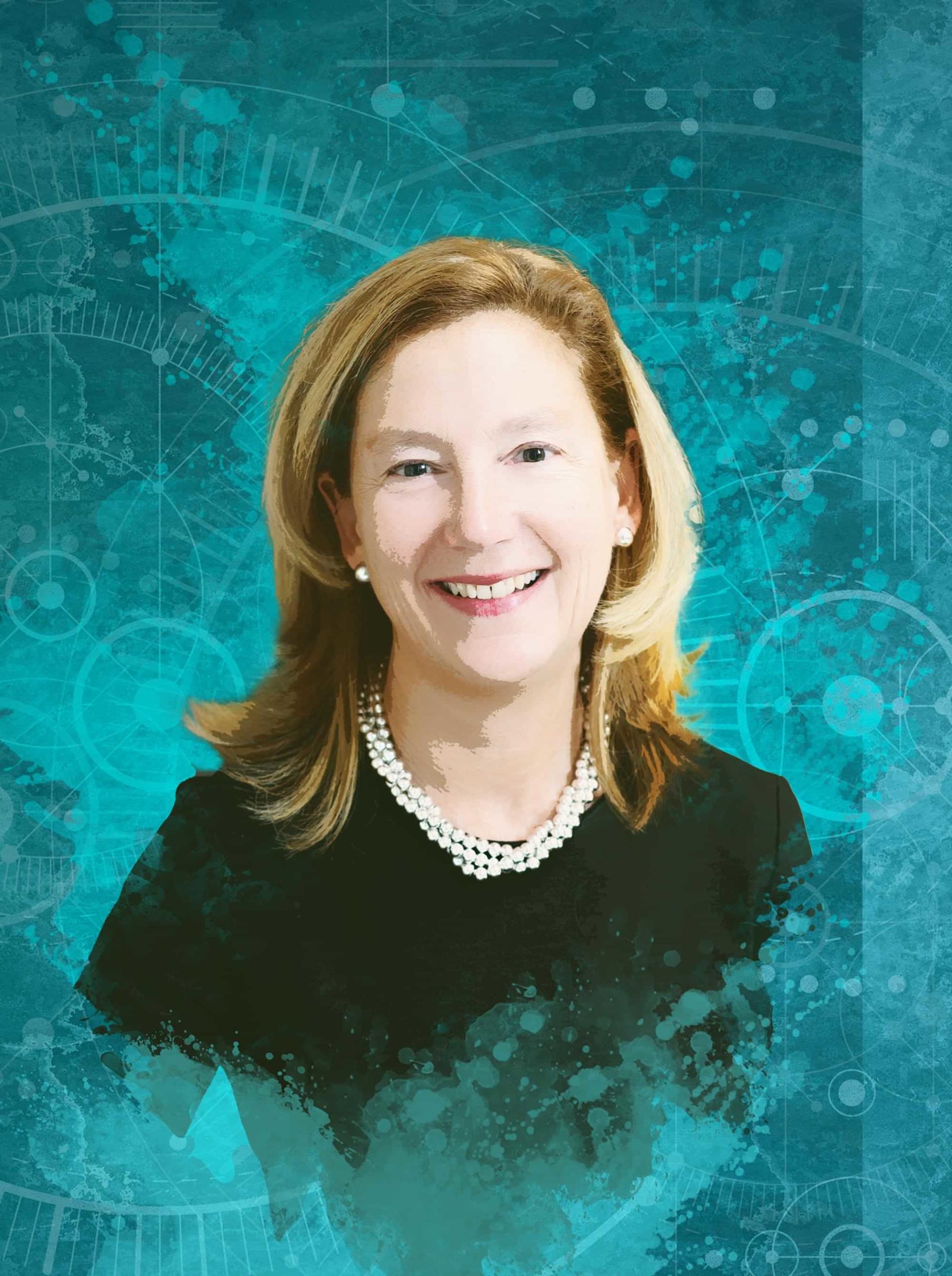
Claiming Their Place in Engineering
Susan Furman Walter ’84, P’14 oversees engineering projects that help communities become more resilient and sustainable

by EVELINE CHAO
illustrations by BARBARA WISE

1. Turning a Grand Vision into Reality
As Stantec’s executive vice president of infrastructure, Susan Furman Walter ’84, P’14 leads the business division in charge of the project’s design. Walter oversees 4,500 employees across North America in Stantec’s billion-dollar infrastructure arm, and has worked on such high-profile projects as Atlantic Yards, which contains Barclays Center, home to the NBA’s Brooklyn Nets.
“I’m influenced completely by Bucknell’s curriculum,” says the civil engineering major, whose senior design project was a conceptual structural redesign of Christy Mathewson-Memorial Stadium. “I remember the curriculum being really hard. But I had great summer internships and awesome professors who spent a lot of one-on-one time with their students.”
Walter is one of many Bucknell alumnae helping to build essential infrastructure, deliver vital solutions to industries and communities, and educate the next generation of engineers — all while improving representation. Women still only hold around 25% of computer jobs, 15% of engineering jobs and 27% of overall STEM positions, according to 2019 Census figures — though for context, women comprised just 14% of STEM workers in 1980.

Taking a Red Pencil to Corporate Speak
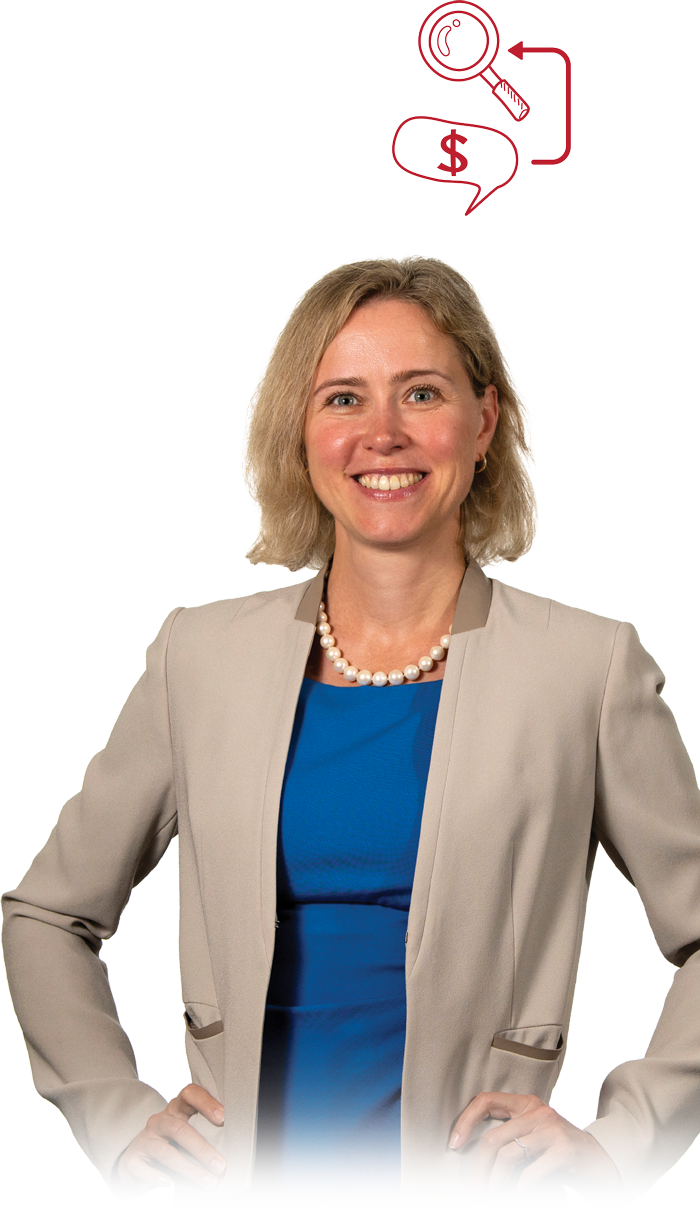
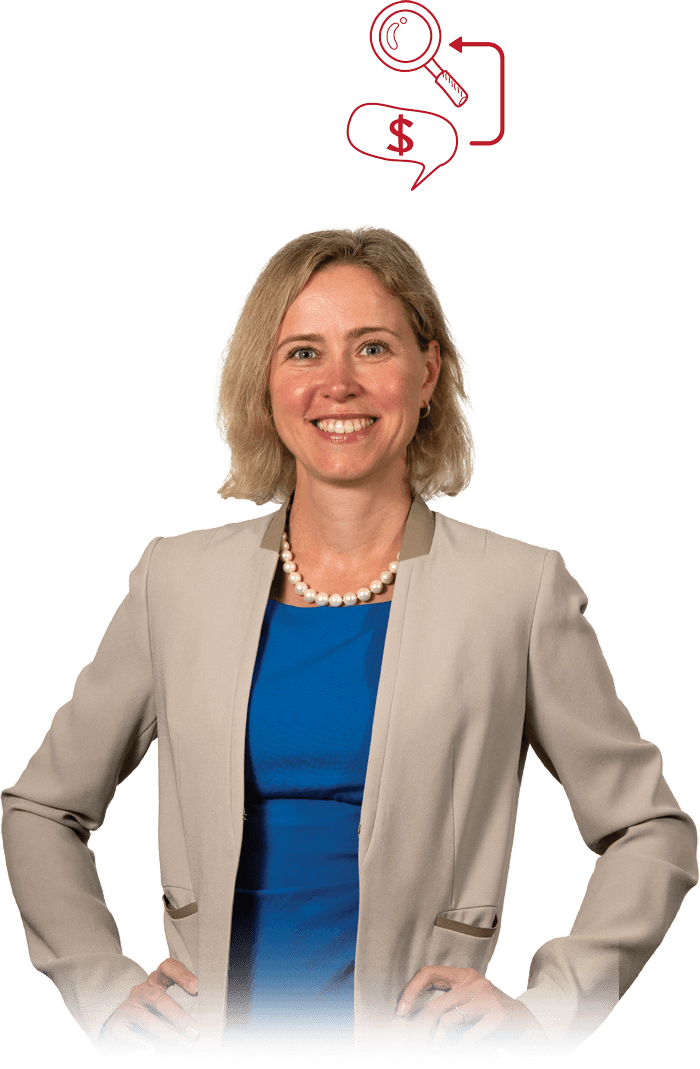
photos by Emily Paine

But she also paid attention to the words chief executive officers and chief financial officers (CFOs) spoke, especially euphemisms like “headwinds,” “rightsize” and “transition period.”
“I noticed that any time things were not going great, managers would switch to this type of language,” she says. “When things were going well, there was none of that.”
That observation fueled her doctoral dissertation, which involved teaching computers to parse the text of corporate disclosures for those euphemisms (a possibility that advances in natural language processing had just begun to make feasible). Her continued curiosity led to several recent, groundbreaking studies she authored or co-authored, most of which focused on how corporate executives speak during earnings calls. What she found was the clear effect those executives’ words have on analyst perception and stock performance.
'ray Bucknell

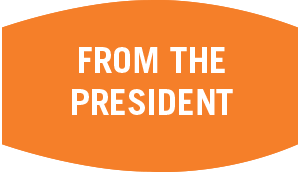
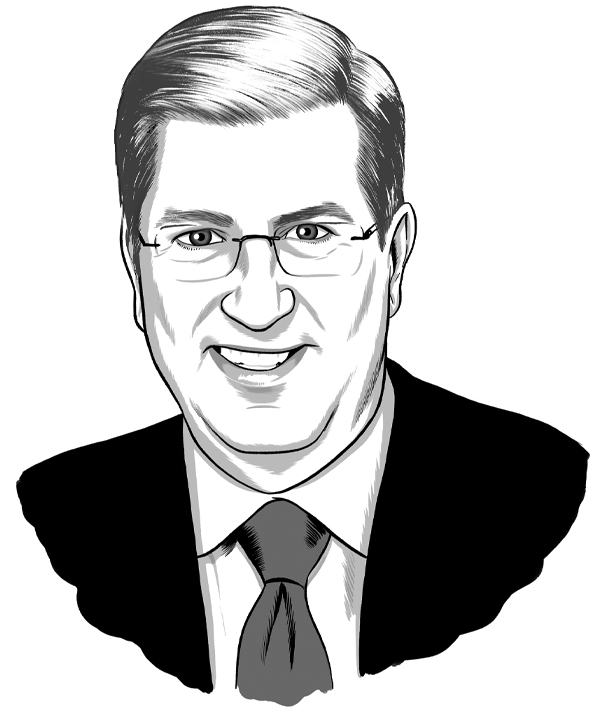
Looking Back, and Looking Ahead
Nonetheless, I soon found myself engaged in lengthy conversations with Ken Freeman ’72, then chair of the Board of Trustees and perhaps the ultimate ambassador for his alma mater. I quickly understood two things: Bucknell is an extraordinarily tightly knit community, and its undergraduate-focused mission holds boundless potential. As the first in my family to go to college, I know the life-changing power of a bachelor’s degree, and I saw the opportunity to lead Bucknell as a way to give back. That summer, Wendy and I arrived on campus with our two-month-old son, Cole.

Paying Tribute to Wilma Soss: An Unsung Hero to Business Women
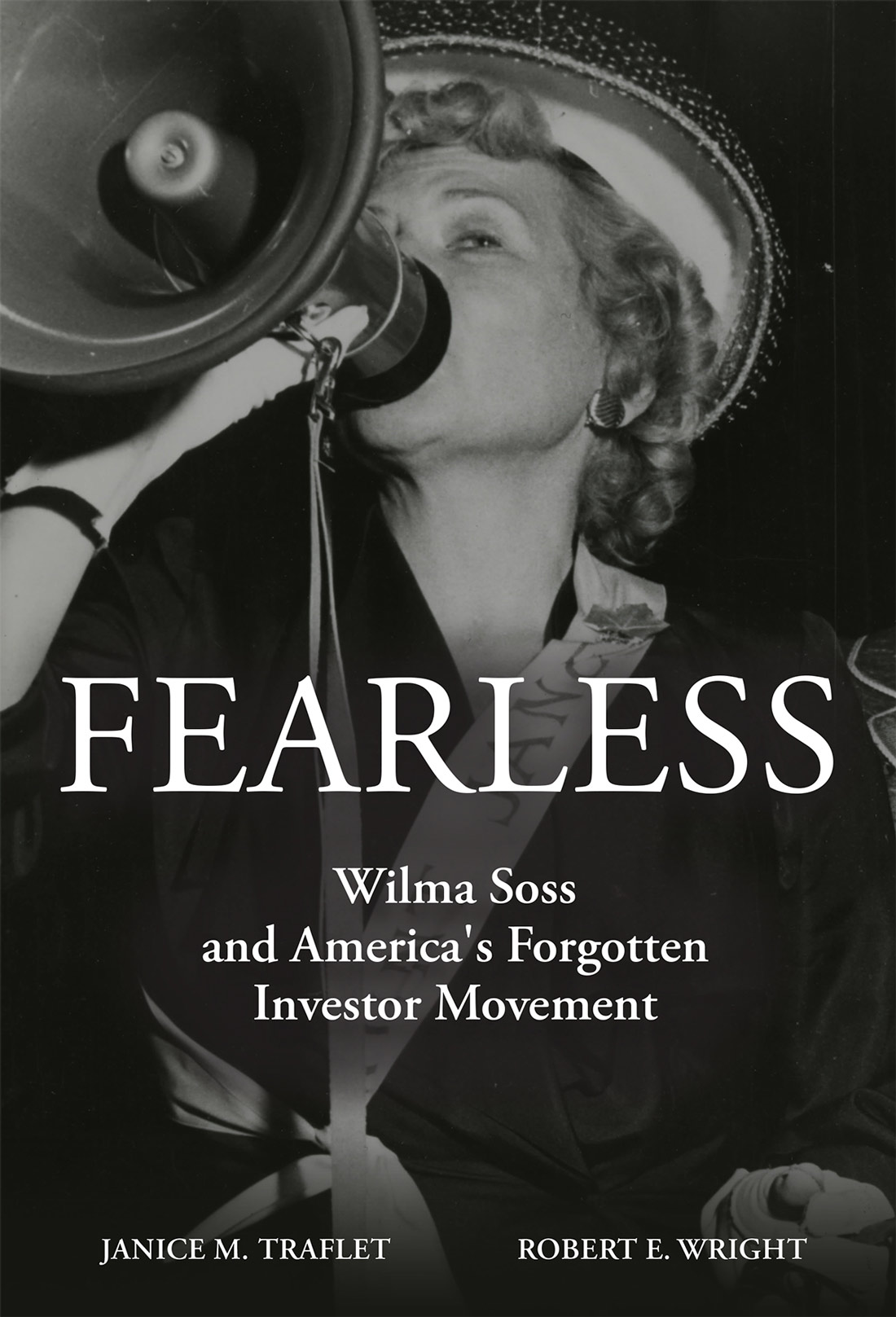
Business women may have Wilma Soss to thank in part for those gains. A shareholder activist who rocketed to fame while fighting for the rights of the individual investor, Soss agitated for a host of corporate reforms that advanced equal opportunities in all areas of corporate America, including boards of directors and executive positions.
Freeman College of Management Professor Janice Traflet has teamed with Robert E. Wright, senior research fellow at the American Institute for Economic Research, to uncover Soss’ contributions for a new generation. Their new book, Fearless: Wilma Soss and America’s Forgotten Investor Movement, may give Soss her belated due.
“Unfortunately, popular memory of Soss’ rich legacy faded in the decades after her death, even though during her heyday she was so popular that a Hollywood movie [The Solid Gold Cadillac, 1956] was loosely based on her extraordinary life,” Traflet says. “Wilma Soss was truly ahead of her time. She was a pioneer financial journalist with millions of devoted followers listening to her NBC radio show, Pocketbook News. She saw the importance of ordinary Americans increasing their financial literacy and getting involved in the stock market.”


When Satchmo Played Davis Gym
1. How did Louis Armstrong end up on Bucknell’s campus?
PROFILE
Sports Medicine Pioneer
“I went to the first game, met the coach and took care of minor injuries,” says Bergfeld, who lettered in football at Bucknell. Despite the fact that sports medicine wasn’t yet a widely accepted area of practice — it wasn’t formally recognized as a subspecialty under the American Board of Emergency Medicine until 1992 — Bergfeld was hooked.
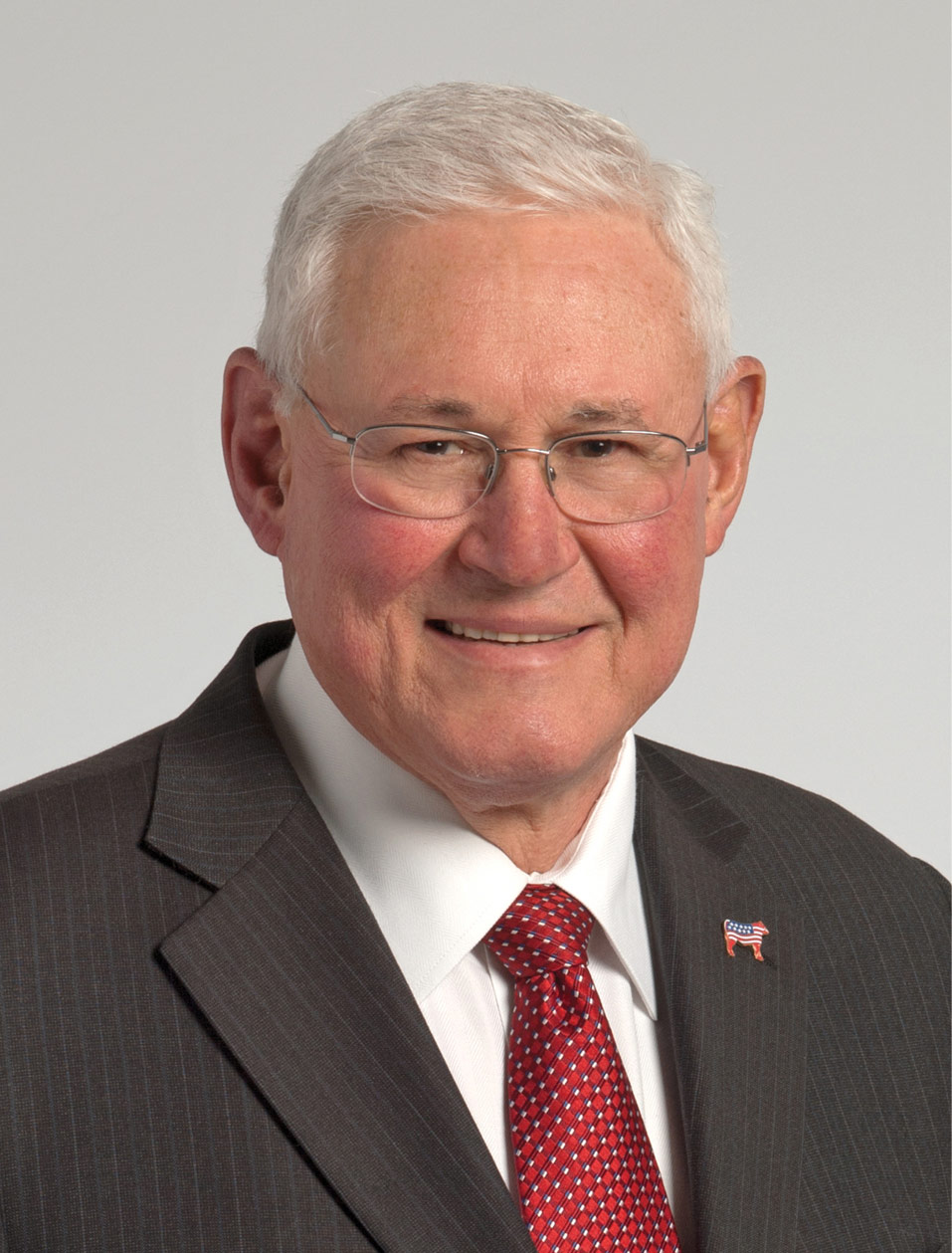

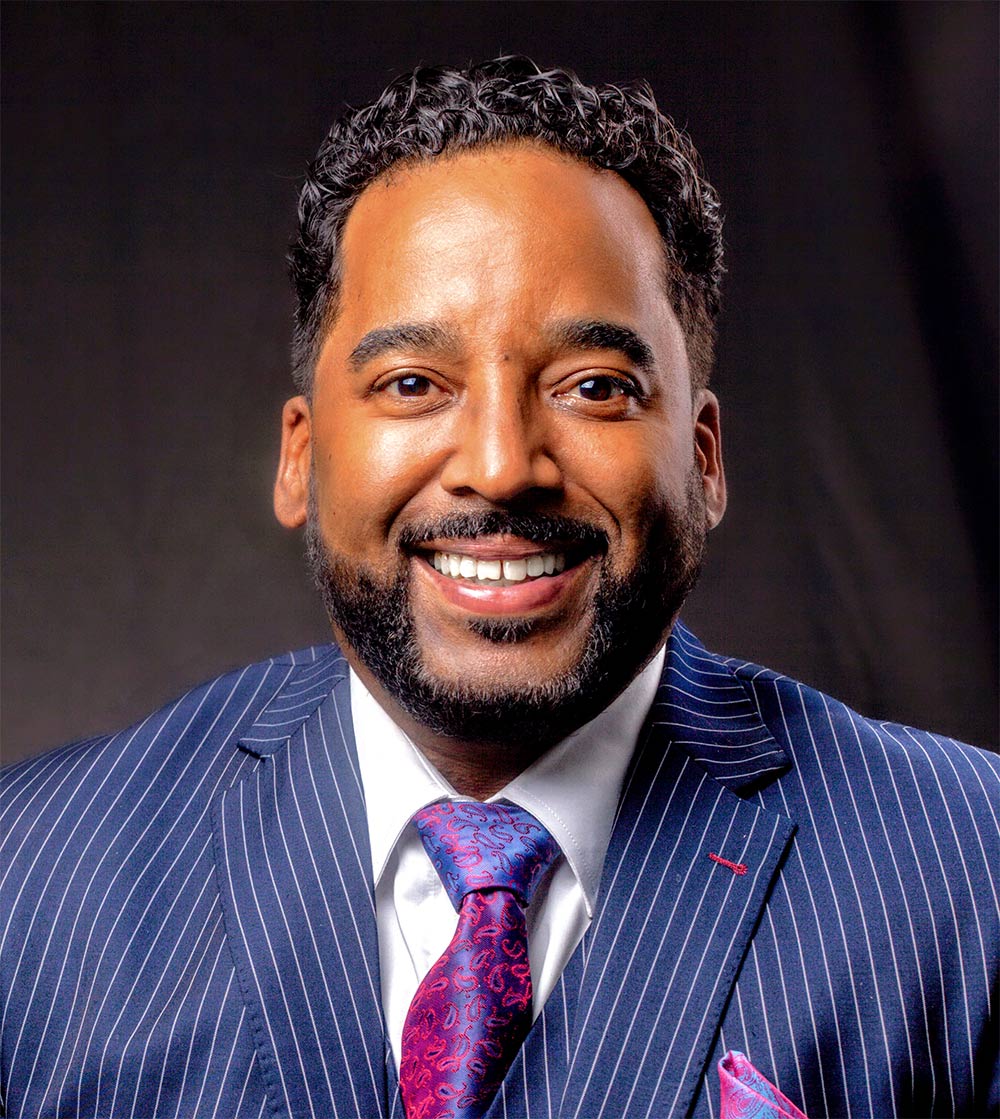
Bridging the Digital Divide
After Bucknell, he attended the Washington and Lee University School of Law, and before turning 27, he established himself as a real estate attorney for one of the largest law firms in the world. But the status (and the paycheck) wasn’t the pinnacle for him.
When the opportunity arose, he traded Washington, D.C., for Syracuse, N.Y., and joined one of the largest developers of private shopping centers in the country. A year later, Henry was breaking ground on a 400,000-square-foot mall in Carlisle, Pa. “It was empowering,” he says. “I needed to know how the deal was cut. That was the piece I was missing. I took a huge pay cut. Everyone thought I was crazy.”
Like many entrepreneurs, Henry’s road to success was not linear. He built two successful, traditional careers, gleaning from them the knowledge and skills that allow him to pursue the purpose-driven work he now leads as the founder, chairman and CEO of two Philadelphia-based social impact firms.
PROFILE
Behind the Screen
Suzanne Méjean Pinney ’03 made art about artists and wound up with two LA Emmys
by Katie Williard
Under bright lights and with bated breath, Suzanne Méjean Pinney ’03 watched the envelopes unfold. She had only prepared one speech but ended up garnering accolades twice in one night as her work was recognized at the Television Academy’s 2022 Los Angeles Area Emmy Awards. A creative filmmaker, Méjean Pinney served as producer and lead editor for a series titled California Graphic Design 1960s – Present, which aired as part of local news network KCET’s Emmy-winning Artbound series. Her efforts won in two categories: best informational series (more than 50% remote) and best arts programming.
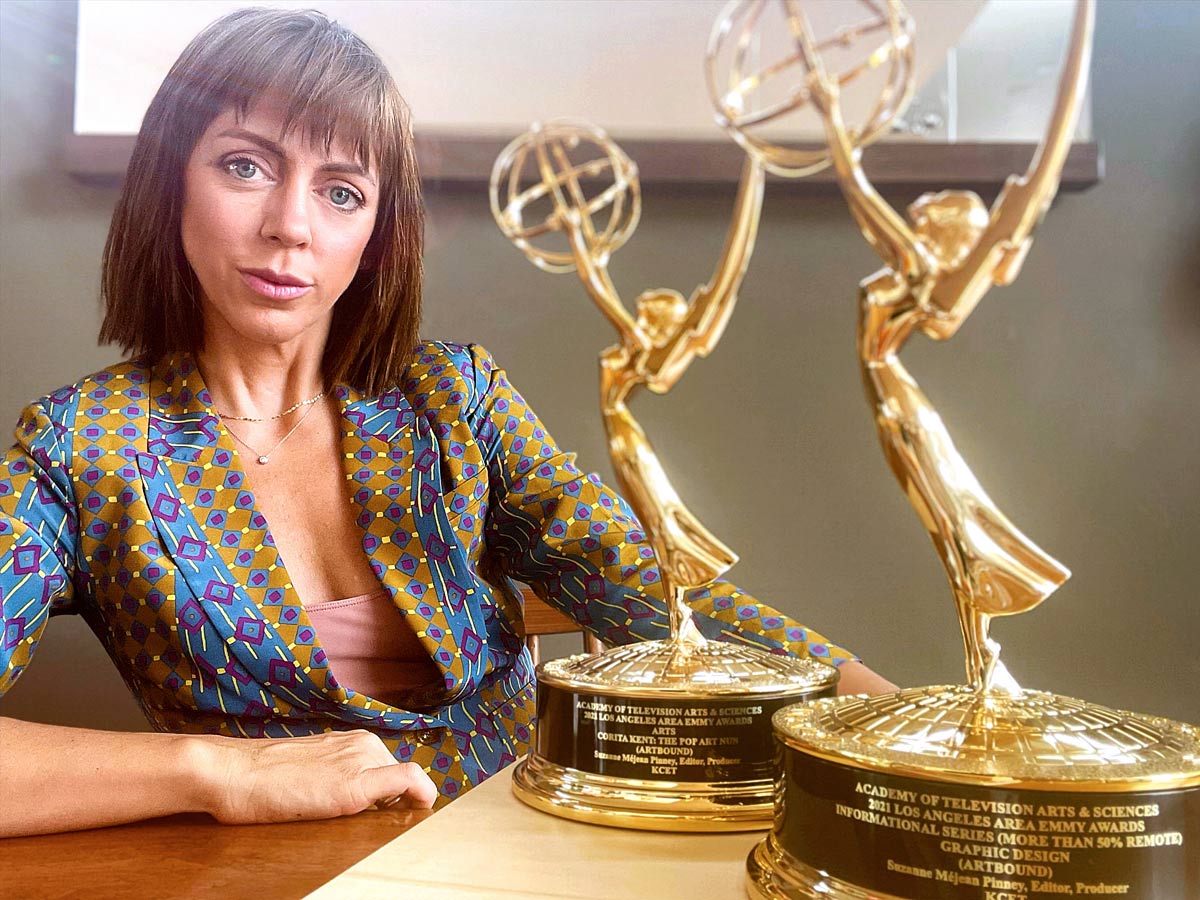
Photo: Suzanne Méjean Pinney ’03
PROFILE
Museum on the Move
Stacey Knepp ’07 is ensuring an important exhibit reaches a wider audience
by Katie Williard
Initially, seeing Americans and the Holocaust required a trip to Washington, D.C. Thanks to the efforts of Stacey Knepp ’07, the exhibit and its compelling message (which inspired the 2022 Ken Burns documentary The U.S. and the Holocaust) have a far greater reach.
From 2021 through summer 2026, the exhibit is traveling across the country, appearing at 100 university and public libraries from Bangor, Maine, to Kapolei, Hawaii.
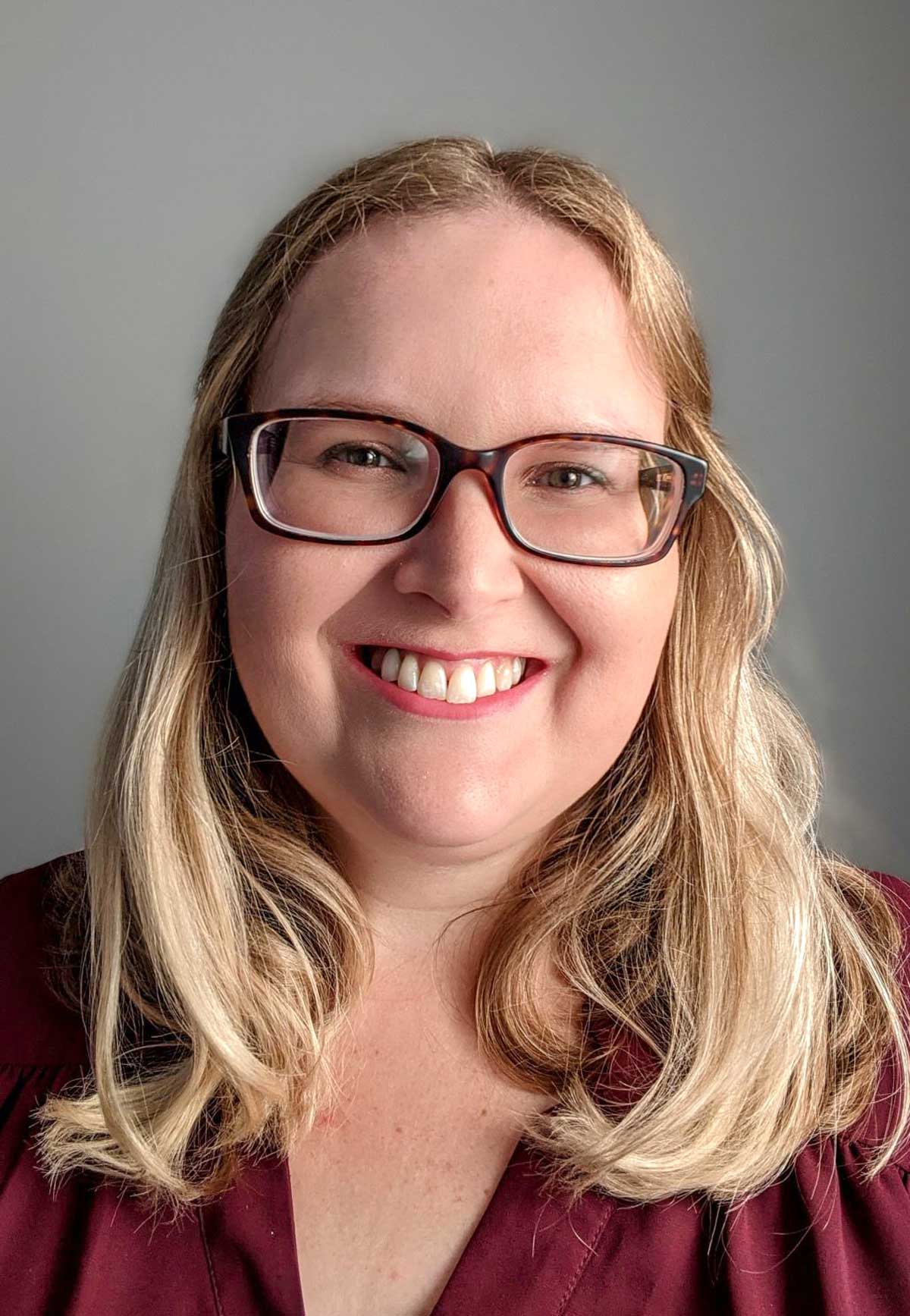
Photo credit: Stacey Knepp ’07
PROFILE
On a Mission
by Brooke Thames
THE MYSTERY AND WONDER of the solar system spark space-exploration fantasies for many children — Kelsey Herrmann ’09 included. Long before she majored in mechanical engineering at Bucknell, Herrmann dreamed of becoming an astronaut.
In time, she realized she didn’t need to physically be in space to reach for the stars. There is an expansive universe of technicians, designers and engineers deeply involved in the operations that enable missions to happen. And today, Herrmann is one of them. As a NASA flight director, Herrmann is working on the Artemis lunar rover, the Volatiles Investigating Polar Exploration Rover (VIPER). In 2024, VIPER will embark on a 100-day mission to collect information about the water at the south pole of the moon, which will help scientists better understand what resources are available for future human missions.
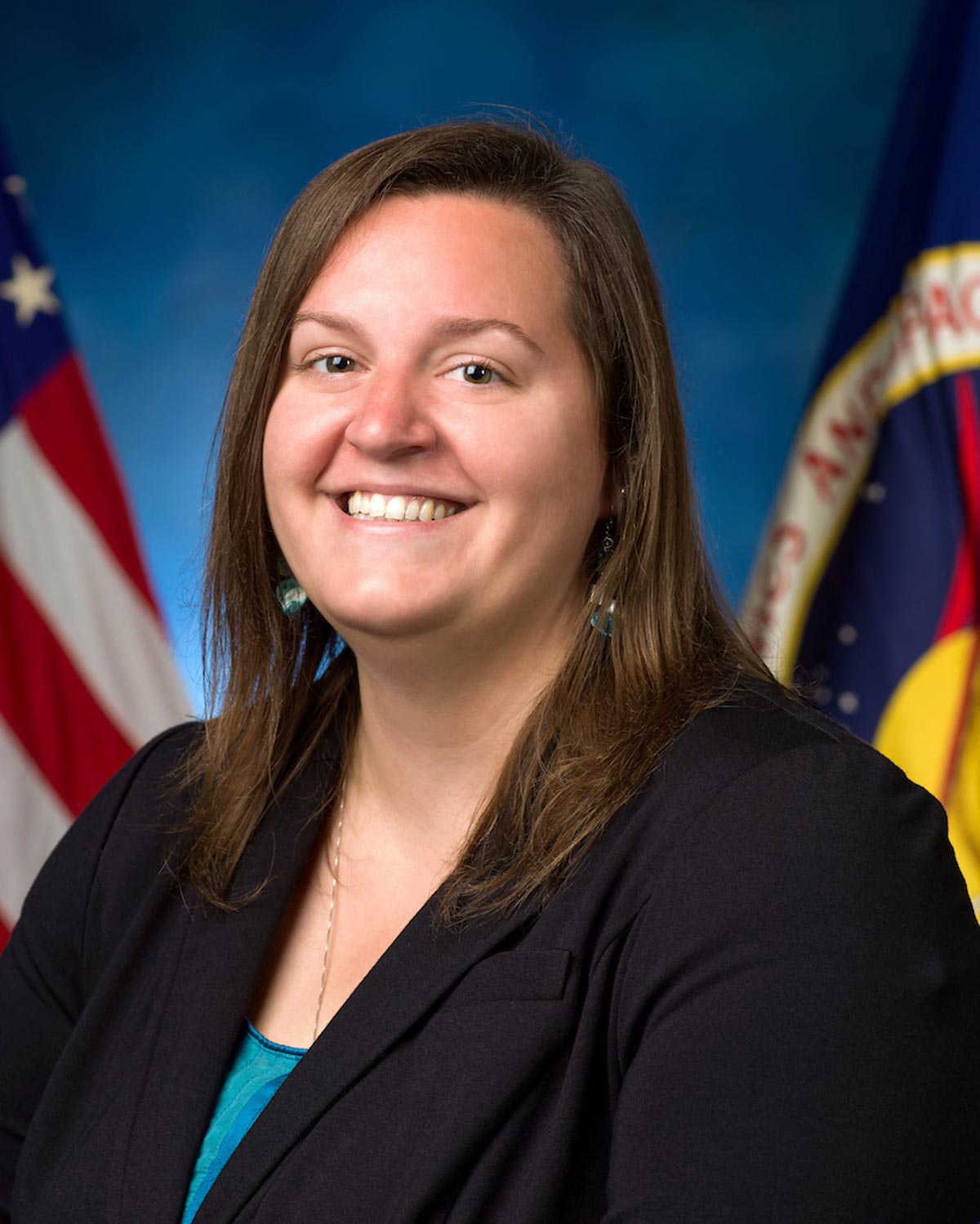
Photo credit: Josh Valcarcel, NASA, Johnson Space Center
IN MEMORIAM
Remember your friends, family, classmates and others by posting a comment on our online Book of Remembrance. Go to bucknell.edu/bmagazine.
1945
Sally Gould Lewis, Aug. 11, Freehold, N.J.
1946
Fred Phillips, July 3, Dalmatia, Pa.
1947
Ray Fornwald, Dec. 16, 2020, Southington, Conn.
1948
Gladys Kurtz Anderson, Aug. 4, Loveland, Colo.
Jane Farr Mayfield, Nov. 25, 2021, Norwalk, Conn.
1950
Leonard Dykins, June 22, Montoursville, Pa.
1951
John Hess, June 26, Dunedin, Fla.
George Olesky, June 30, Maple Shade, N.J.
1952
Robert Grice, Aug. 10, Loudonville, N.Y.
1953
Thomas Force, July 31, Cuyahoga Falls, Ohio
Claire Vogelsong Pease, July 28, Anchorage, Alaska
Mary Vanek Sites, July 10, Atkinson, N.H.
in memoriam
James Turnure Sr. P’82, Professor Emeritus, Art History
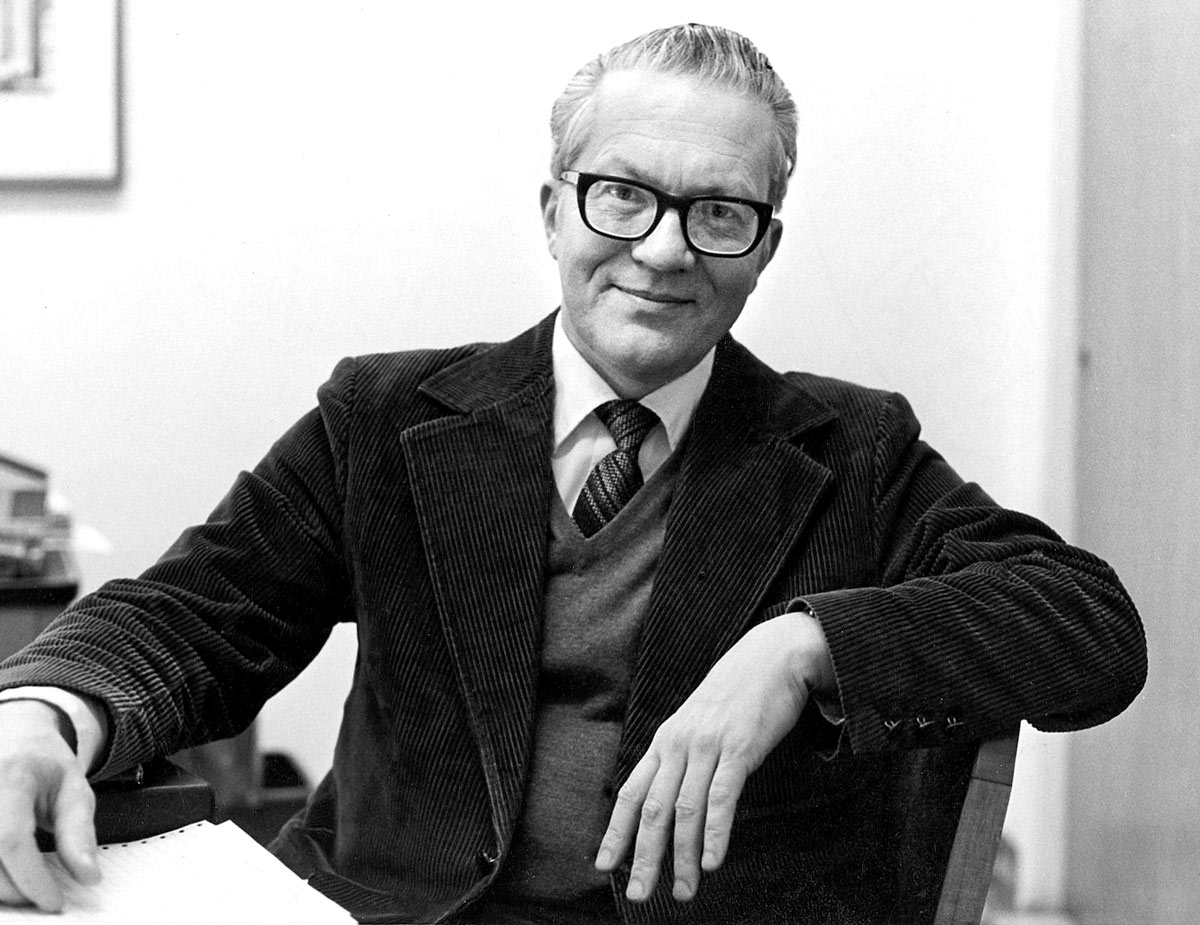
Photo credit: Special Collections/University Archives
Turnure came to Bucknell in 1968 to serve as department chair. Professor Emeritus William Lasansky, art, and his wife, Jeannette, remember his immediate impact. “He was quite a teacher and affected all students — not just art majors,” William says. “He opened the door to art history in a way and at a scale that was amazing.”
His introductory course Art in the Dark — which covered classical, Roman and Greek art and progressed through the modern era — sparked art appreciation in the hearts of countless Bucknellians. The course was so popular, the Lansanskys say the registrar moved it to a less desirable time slot. “They made students get up early for him,” Jeannette says.
His teaching went far beyond opening the door to art appreciation. “He saw the importance of students learning about art by viewing objects,” says Professor Emerita Rosalyn Richards, art & art history. “His course Analysis of Art showed students materials like lithography stones and tools so they understood the art-making process.”
DO
Explore Job Opportunities
Mark Your Calendar
Join us for an expanded on-campus experience featuring your favorite Bucknell traditions Sept. 22-24, 2023.
Stay in touch!
Answer This:
FOLLOW US ON FACEBOOK TO SUBMIT YOUR ANSWER
Crowdsourced
How did you get your college nickname?
Celebrate an Engineering Milestone
Bucknell’s College of Engineering will host its annual National Engineers Week — or E-Week — Feb. 19-25. E-Week celebrates the accomplishments of students and faculty in Bucknell’s six engineering departments and also commemorates the 100th anniversary of the first woman to graduate from Bucknell with a degree in engineering. The festive week will culminate with a Friday dinner — alumni are invited to attend.
Attend the Bucknell Forum
Remember the Mods
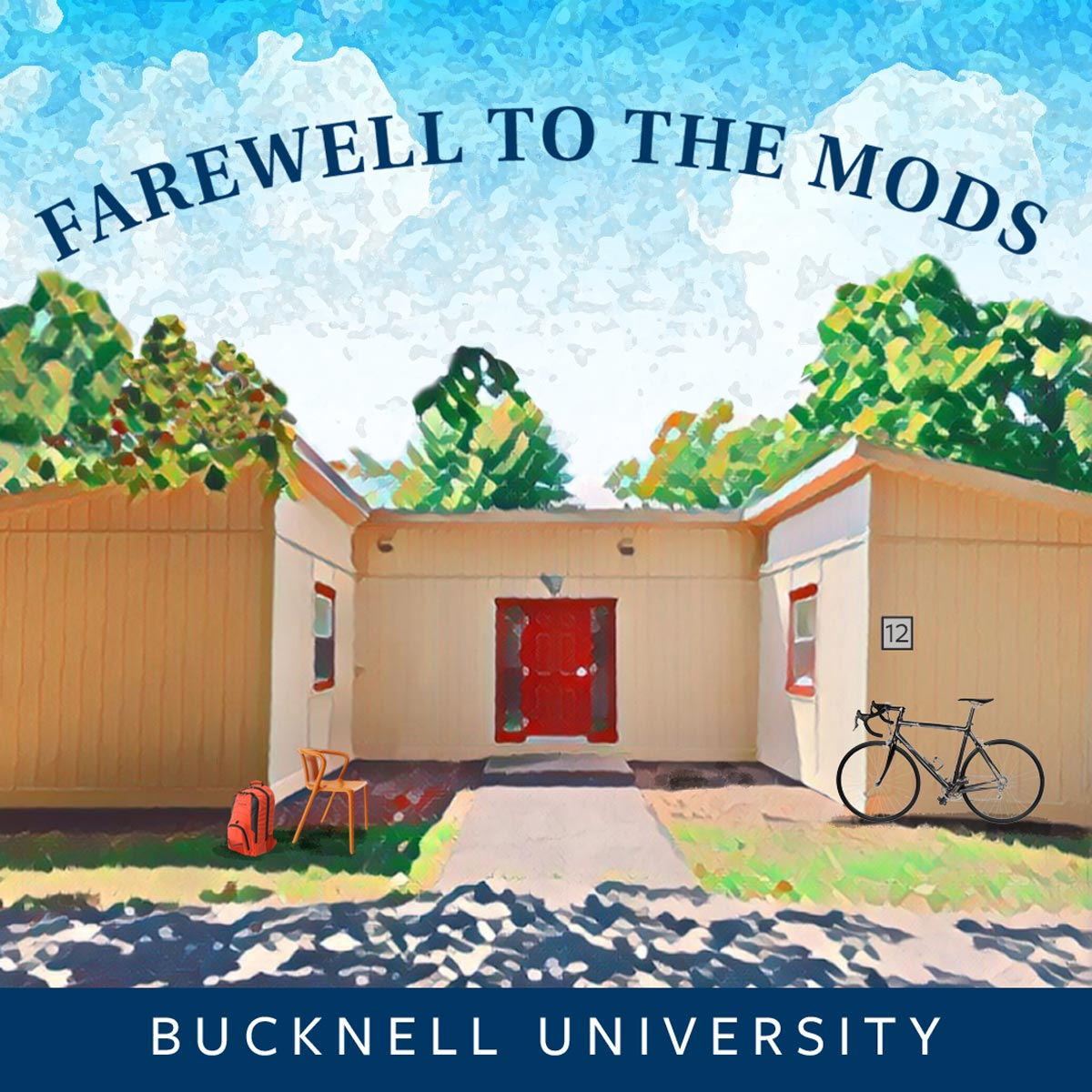
The Mods have withstood the test of time for 50 years, offering students a distinctive living experience. As we look to the future with the construction of four new Bucknell West residence halls, we want to reflect on our experiences and memories made across Route 15. We invite you to join us in saying farewell to the Mods. Here’s how you can participate:
Share photos from your time in the Mods
Mark Your Calendar
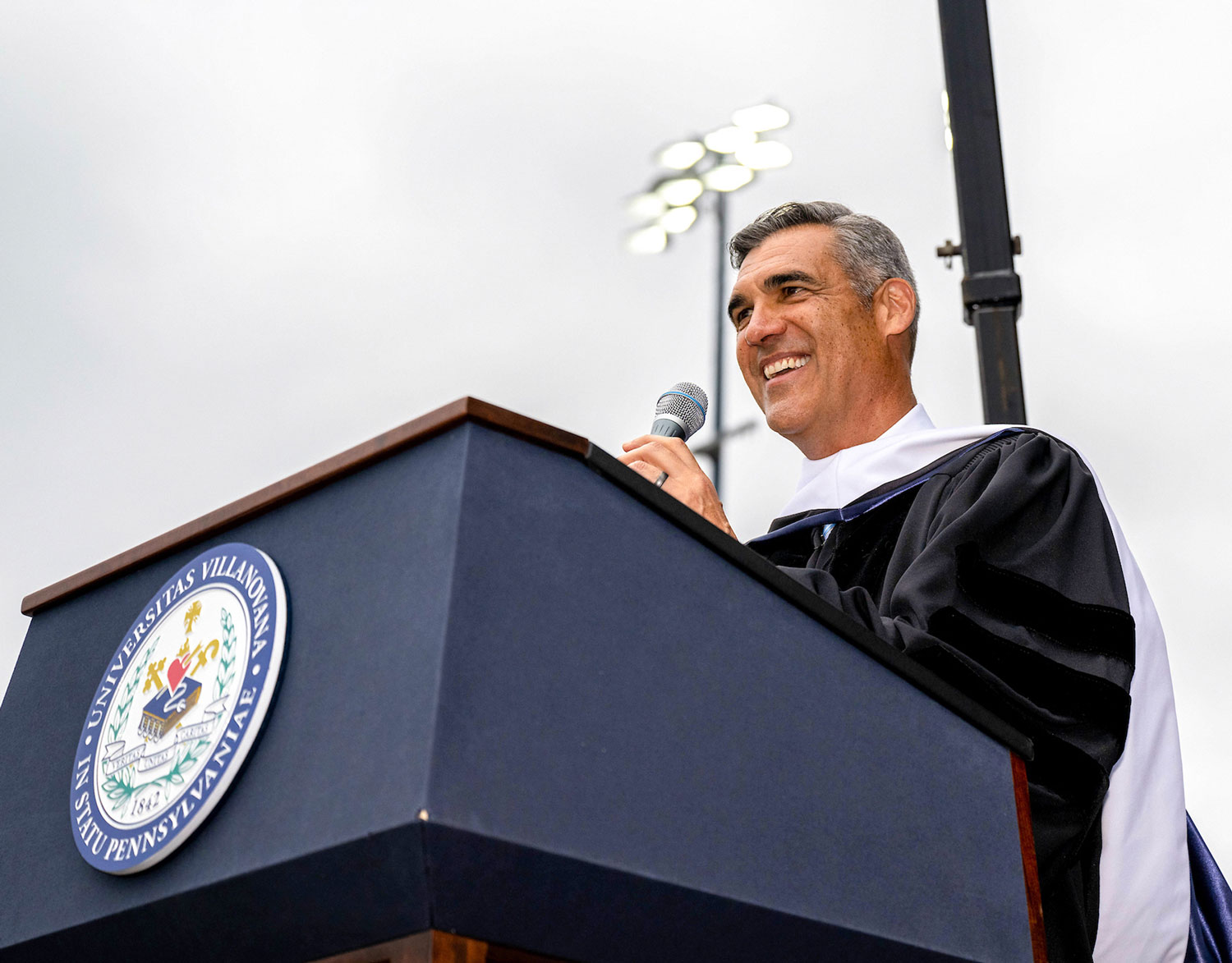
Photo: Villanova University/Paul Crane
Wright became head coach of the Villanova men’s basketball program in 2001 and posted a record of 520-197 (.725) in 21 seasons, which included national championships in 2016 and 2018. In his final season, Villanova advanced to the fourth NCAA Final Four of Wright’s tenure. He also coached Hofstra University from 1994 through 2001, winning 642 games during his coaching career.
“I am humbled and honored to return to my alma mater Bucknell University — a place I love — to deliver the commencement speech to the Class of 2023,” says Wright. “Bucknell prepared me for my professional life, opened my eyes to the world and provided me with the most valued lifelong friendships. I hope I can impart some value and wisdom to the Class of 2023 that can compare in a small way to the education and life lessons I learned in my four years on the beautiful Bucknell campus.”
Witty Winners

Submit your caption for the retro photo on Page 61 to bmagazine@bucknell.edu or facebook.com/bucknellu by Feb. 28.
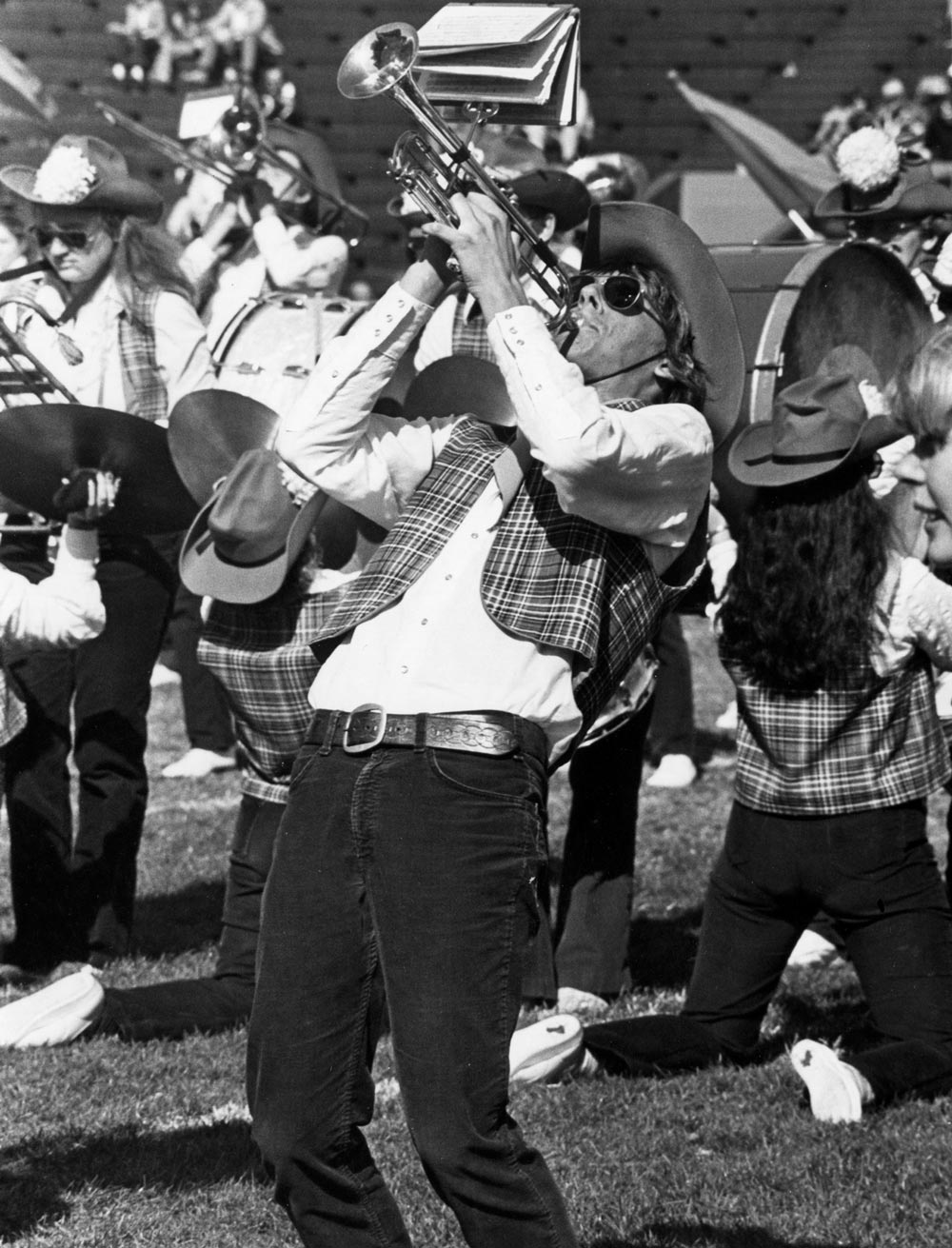
Photo: Special Collections/University Archives
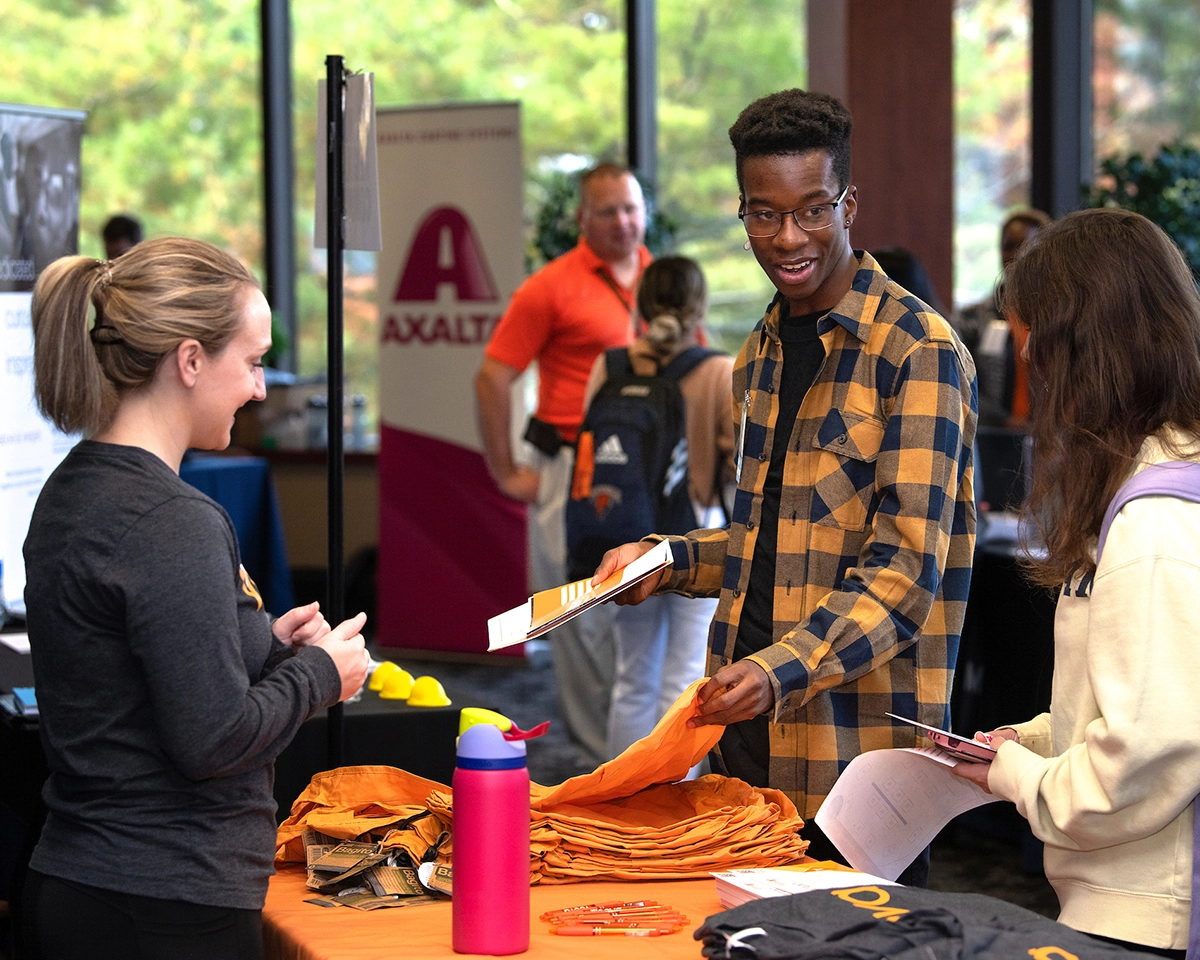
Photos: Emily Paine
Pave the Way
 Bucknell’s Center for Career Advancement launches a new approach to career exploration
Bucknell’s Center for Career Advancement launches a new approach to career explorationLaunched in fall 2021 by Bucknell’s Center for Career Advancement (CCA), Career Communities introduce students to six industry-specific career groups: Business & Consulting; STEM; Creative Arts, Media & Communications; Government & Public Interest; Law; and Health. Students can join as many communities as they desire — starting their first year at Bucknell — while they discern their best path forward.
The fresh approach is a differentiating factor in the way Bucknell does career coaching. Career coaches help students break down and identify their career interests, recognizing students’ preferences may fall outside what might be obvious for their major.
“Just because you study engineering or English doesn’t mean that the person sitting next to you with the same major will choose the same career path,” says Emily Dietrich, associate director of industry connections & experiences. “Career Communities offer students the opportunity to build community outside their major with others who are interested in a similar career path.”
photograph by Madeline salvani
